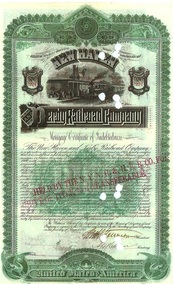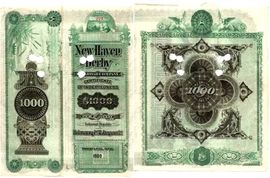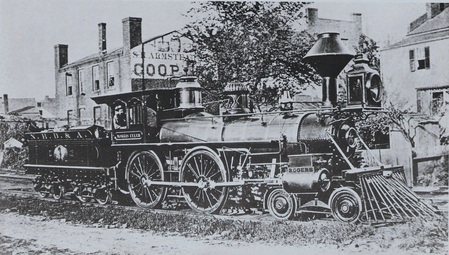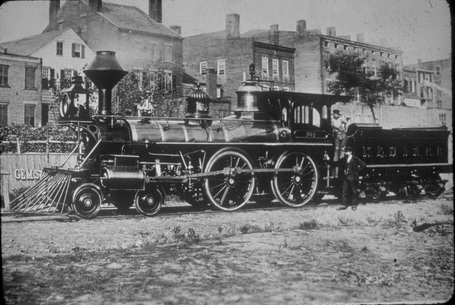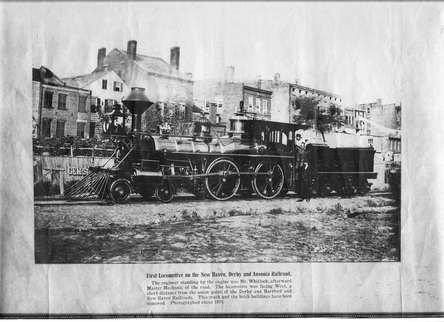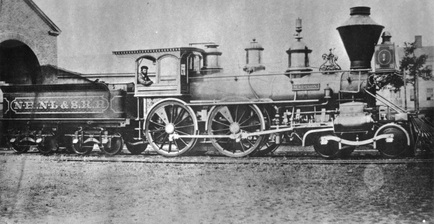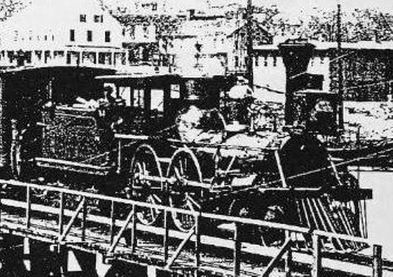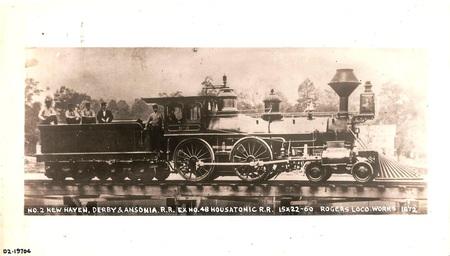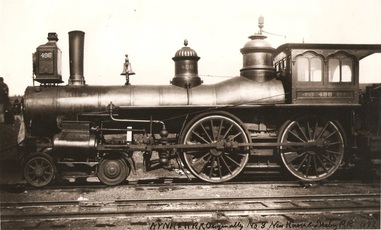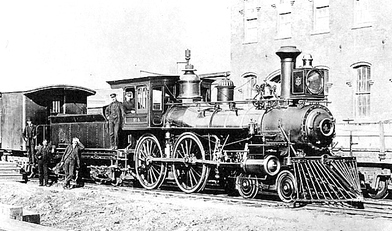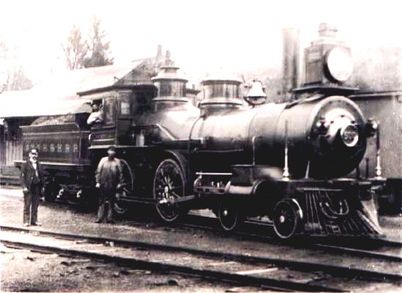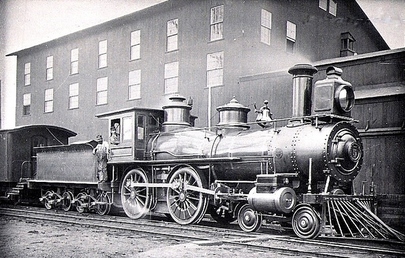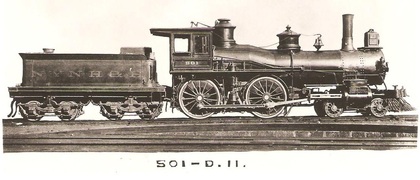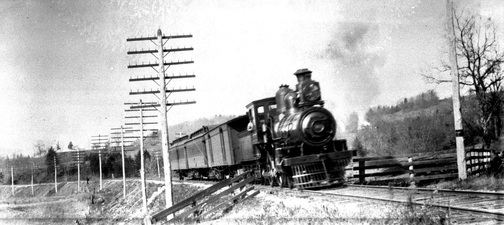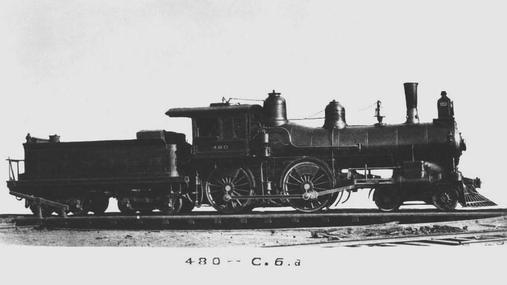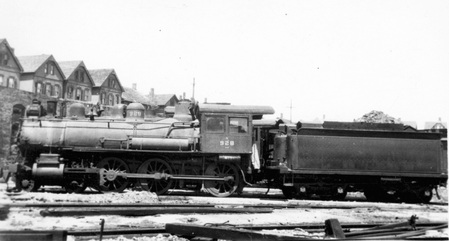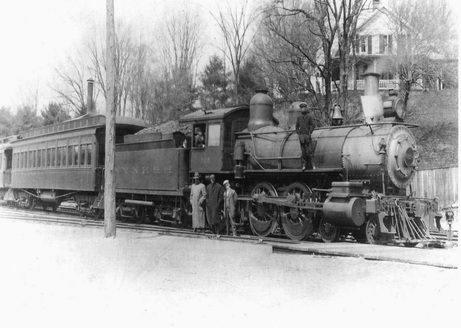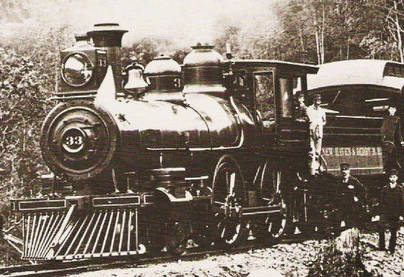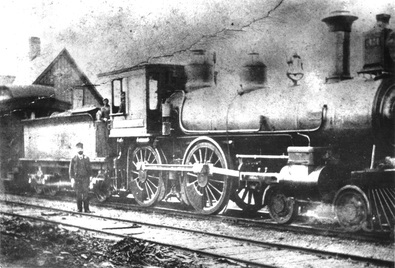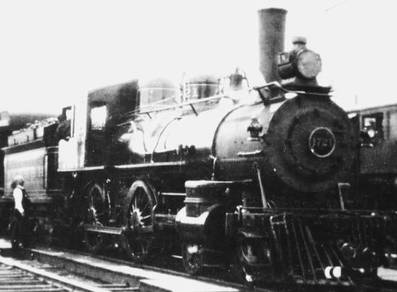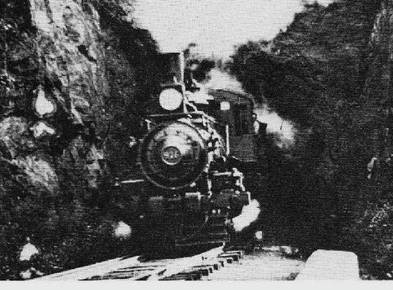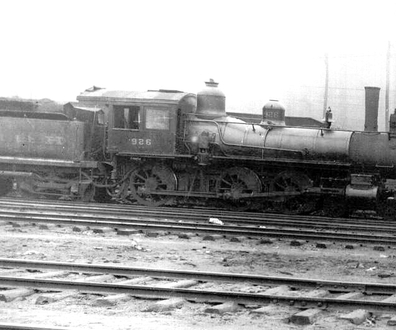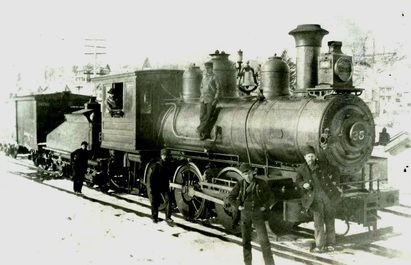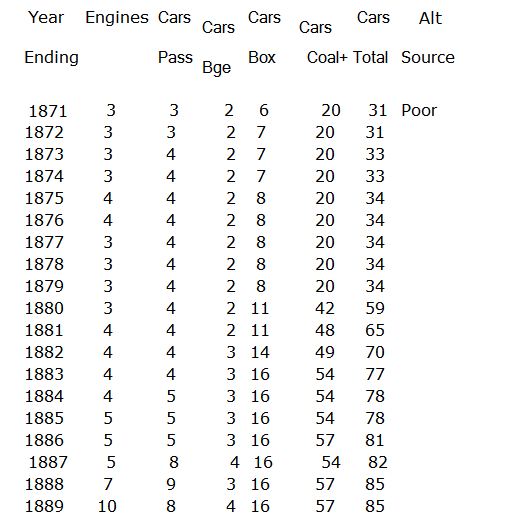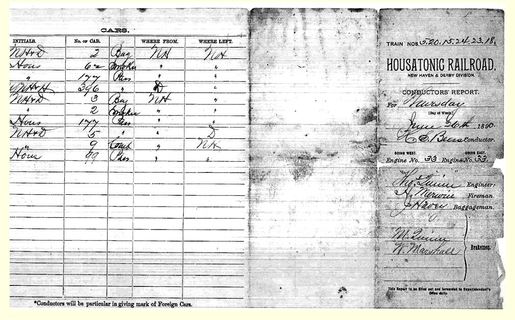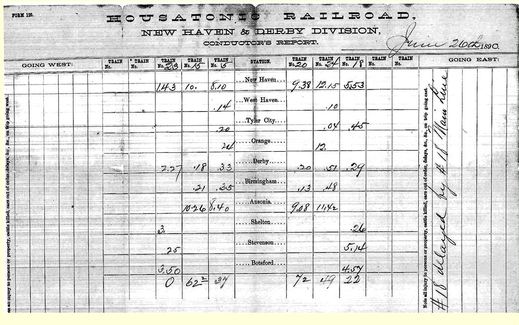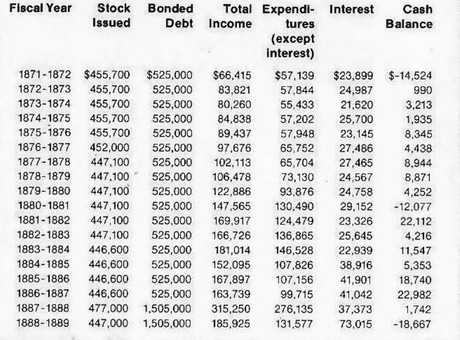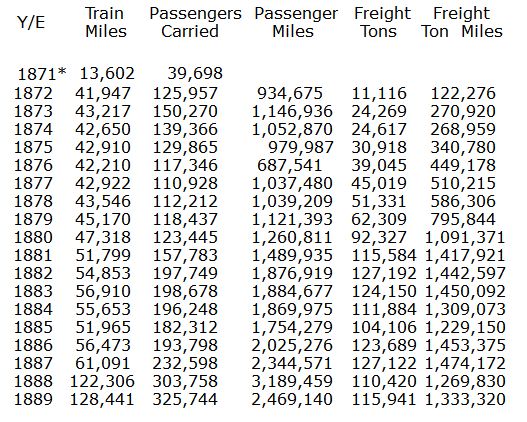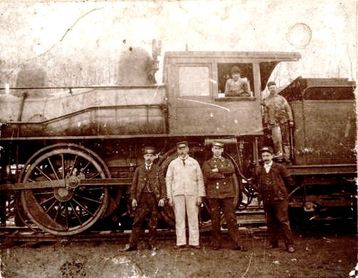Track 3 - New Haven & Derby Extra
Track 3.0 Documents
Track 3.1 Locomotive Roster
Track 3.2 Locomotive Photographs and Data
Track 3.3 Equipment Roster
Track 3.4 Financial Statistics
Track 3.5 Operating Statistics
Track 3.6 Officials and Personnel
Track 3.7 Biographical Gallery
*******
Track 3.0 Documents
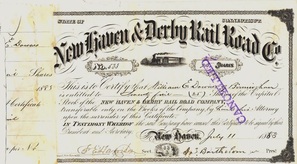
Richard A. Fleischer Collection
[3.0.1] Stock certificate #533 for 25 shares of the NH&D, purchased on July 11, 1883, by William E. Downes of Birmingham, a director as well as builder and owner of the road's station in that borough. The certificate is signed by President J.H. Bartholomew and Secretary Francis E. Harrison.
[3.0.2] Mortgage certificate #221 from the $800,000 issue of August 1, 1888, signed by President William H. Stevenson and Secretary A.H. Kellam. These certificates matured on February 1, 1900 and earned 6% interest, payable semi-annually. By 1892, the NYNH&H would get control of the NH&D, along with its indebtedness in stocks and bonds like this and the item above. The NH&D, now a ghost entity run by a paper board of directors who were Consolidated officials, surrendered its franchise on March 26, 1907 and thus ended a corporate existence that began on June 9, 1864. The process of securing every last share of stock was not an easy one but it was necessary for the dissolution of the company: see Track 1, MP 1.28. The stamped line says: "HELD BY THE N.Y.N.H. & H. R.R. CO. FOR SECURITY OF TITLE, NOT TRANSFERABLE. The legalistic language was both sad and true; it was not transferable because the NH&D was essentially gone or soon to be. We have been unable to determine any actual transfer date on this document. The image at right is the reverse side.
Track 3.1 NH&D/HRR-era Locomotive Roster
Livery Builder Bldr# BuildDate Type HRR# NH#1892 NH#1904 Retired
NHD&A#1 RL&M 1857 02/13/1871 4-4-0 47 497 --- <1900
NHD&A -- RK&G 147 10/12/1848 4-4-0 -- --- --- 11/77-11/78
NHD&A -- RK&G? 215/218 1850 4-4-0 -- --- --- 02/20/1880
NHD&A#2 RL&M 2083 06/13/1872 4-4-0 48 498 --- <1900
NHD&A#3 DL&M 990 07/00/1874 4-4-0 49 499 --- <1900
NH&D#4 DL&M 1225 08/00/1881 4-4-0 50 500 2041 04/06/1907
NH&D#5 CL&M 1647 06/08/1885 4-4-0 51 501 1915 04/30/1915
NH&D#30 RL&M 3940 05/08/1888 4-4-0 30 480 1724 08/18/1919
NH&D#31 RL&M 3944 05/23/1888 4-6-0 31 481 928 12/31/1915
NH&D#33 RL&M 4127 04/08/1889 4-4-0 33 483 1721 05/00/1923
NH&D#34 RL&M 4124 02/27/1889 4-6-0 34 484 926 05/00/1923
NH&D#35 RL&M 4133 04/24/1889 0-6-0 35 485 2519 06/00/1923
Rogers, Ketchum and Grosvenor [RK&G] would later become Rogers Locomotive & Machine Works [RL&M] Click here. Danforth, Cooke and Co. became Danforth Locomotive & Machine Co. [DL&M] and later Cooke Locomotive & Machine Co. [CL&M]. Click here.
The locomotives are listed above, with the exception of NH&D Nos. 33 and 34, in order of their arrival. From the photos we have of Nos. 1 and 2, the livery on the early locomotives built for the New Haven and Derby RR was NHD&A to tout the road's completion to Ansonia. Since these were numbered consecutively, the Branford and the Edwin Marble, the second and third engines on the list, were apparently not numbered into the roster, though they probably carried the NHD&A livery. The Cooke roster [CF&G, see below] lists Nos. 3-5 as going to the NH&D, possibly meaning that the livery had dropped the 'A' by then, though the note pages in the back say these engines went to the NHD&A. By the time the NH&D affiliated with the HRR, the Branford and the Edwin Marble were long gone and locomotives Nos. 1 through 5 were renumbered into the HRR roster, possibly as early as September, 1887 [NHER/09/10/1887/01] and certainly by 1889. To reflect the completion of the Extension in 1888 with the addition of Botsford as a terminus alternative to Ansonia, the 'A' was probably dropped on any engines that still had it. This would have made these engines match the five new locomotives purchased in 1888 and 1889, which were given HRR numbers but lettered as NH&D. All were subsequently renumbered by the NYNH&H in 1892 and again in 1904.
References:
Steam Locomotives of the New Haven Railroad by Charles E. Fisher [cited hereafter as SL], originally published as a series of articles in the Bulletin of the Railway & Locomotive Historical Society, 1936-1959. The copy used here was a 1981 edition that reprinted the original articles with corrections and additional information by William D. Edson. One of the original articles [Bulletin (1937) 44: 67-68] covered the HRR locomotives;
"Rogers Locomotives: A Brief History and Construction List" by Peter Moshein and Robert R. Rothfus [cited hereafter as RL] in Railroad History (1992) 167: 13-147. This publication is the former R&LHS Bulletin, retitled in 1972;
Official Cooke locomotive records, typewritten and indexed, supplied by the American Locomotive Co. (Alco), which absorbed Cooke in 1901, with edits, notes, and much additional research by Charles E. Fisher, F. Stewart Graham and others [cited hereafter as CF&G]. There exists an additional Cooke list, handwritten and attributed to Harold Goldsmith [cited hereafter as CG] with a second list appended that seems to be duplicated in CF&G. All these lists are not well documented. If the supporting papers and notes are found to be available, it will help all of us to determine the sources consulted and weigh them appropriately in our continuing research.
A History of the American Locomotive: Its Development, 1830-1880, by John H. White, Jr., 1979 [cited hereafter as HAL];
A Short History of American Locomotive Builders in the Steam Era, by John H. White, Jr., 1982, cited hereafter as SH; and,
NYNH&HRR Classification of Locomotives, for 1900 and 1919, cited by date under 'Data' below.
Track 3.2: Locomotive Photographs and Data
Photos/liveries needed
NY&NH #6 #14? #44
NHNL&S/SL #7
NHD&A #3, Branford, Edwin Marble
NH&D #30 #31 #34 #47 #48 #49 #50 #51
NYNH&H #483 #484 #485 #497 #499 #500 #1915 #2041 #2519
__________________________________________________________________________________
Track 3.2.0: NHD&A #1, Morris Tyler
We are not sure of the provenance of this bottom photo. While the caption plausibly explains the location, it says nothing about this being the Canal line, which 'Gem St.' on the fence proves it is: see Track 4A, MP 4.1 and 4.2. The captioning also says that this track and the buildings have been removed. The Canal line track would not be removed until the 1980s and some of the buildings are probably still there today in 2009. See below at MP 3.6.2 for J.M. Whitlock as the master mechanic, otherwise known as chief engineer, who has never been identified before in other copies of this photograph. The writer of the caption, quite knowledgeable in many period details and somewhat unknowing in others, as well as the circumstances of the production of this image are otherwise a mystery.
Years/Livery/Photos
1871-18??: NHD&A - Morris Tyler [top photo]
18??-1887: NHD&A 1 [middle, bottom photos]
1887-1892: NH&D 47 [no photo]
1892-1900: NYNH&H 497 [no photo]
Data
[1871] RL&M #1857; 02/13/1871; 4-4-0; 15x22" cyl.; 60" drivers; road no. --, named Morris Tyler, NH&D [RL: 67]. Fisher says #J748, NHD&A #1, Morris Tyler [SL: 47].
[1900] Retired prior to 1900.
Notes
1) NHDP/02/28/1871//02 says the new engine for the Derby railroad, built by the Rogers Company of Paterson, New Jersey, is at Morris dock, New York, and is to be brought to this city soon. According to the Rogers delivery book, this engine was "started" for the Connecticut Western RR [RL: 67] but wound up as one of two locomotives ordered by the NH&D. The order for the other engine was cancelled. See below at MP 3.2.01, Note 3. Surprisingly, Rogers had no rail connection in Paterson. Its finished engines were drawn by horses to the nearest railroad, the broad-gauge Erie, and put on flat cars for further shipment. The Morris Tyler may have gone either north to Piermont or south to Jersey City to be ferried across the Hudson River. Morris Dock on the Harlem River was both a port and a station on the Spuyten Duyvil and Port Morris RR, which was being completed in 1871 to link the Hudson and Harlem lines [click here and look in the center of the map above 'Tremont']. We are not sure of the state of completion of this road in March of 1871 and whether there would yet have been a connection at Mott Haven with the Harlem mainline to access the NY&NH for the trip up to Connecticut. We also don't know whether the NHDP may have confused Port Morris with Morris Dock. There had been a short rail branch in place from Port Morris to the Harlem road since 1842. There is a note in the Rogers record books about the 1874 delivery of a Shepaug RR locomotive that was damaged enroute and repaired at Port Morris, N.J. [RL: 78]. The 'N.J.' is probably an error since Port Morris, N.J. is in the western part of that state. If Port Morris, N.Y. was meant and figured as a part of a regular shipping route for Connecticut-bound locomotives, then that might be another argument both against the Morris Tyler being at Morris Dock and for its shipment via Jersey City.
2) NHDP/03/03/1871/02 says the new engine for the Derby road is named "Morris Tyler" and is at the Canal road's engine house. It weighs 27 tons and the size of the cylinder is 15X22.
3) NHER/03/03/1871/02 says the new engine for the Derby Railroad is quartered at the engine house of the New Haven and Northampton Railroad and "it has been named 'Morris Tyler' after the President of the road."
3a) HDC/03/04/1871/01: "The new locomotive for the Derby railroad is named "Morris Tyler."
4) The favored theory at this point is that the top photo is the Derby road's first new locomotive looking as it was delivered, posing just north of the Canal road engine house where it was kept. The side of the tender sports a landscape scene of a bird, perhaps an osprey, sitting atop a tree. This kind of adornment was fairly common at the time. According to the Palladium, NYNH&H No. 97, finished at the New Haven shops on 09/16/1880 [SL: 13], would have full-color paintings of Lion Hunt in a Desert [artist Horace Vernet(?)] on one side of the tender and The Stag on the other, as well as a collie and pup on one side of the headlight and a pair of deer on the other side [NHDP/09/20?/1880/04; see also HAL: 219]. Our engine has the foliage-style headlight brackets that were often seen on new Rogers locomotives, like on NHD&A #2 at MP 3.2.2. This new engine has just the name Morris Tyler, as the Rogers delivery book says [RL: 67]. There is no number either on the smokebox door where there is a simple, traditional star or on the tender, though the image there has been mistaken in the past as the numeral 1 - see Al Lawrence's sketch at the top of each Track page. The lower photo would even seem to support this theory that it is the later of the two photographs, since it shows what may be remnants of the nature motif with swans on the sandbox and the the dog and lighthouse on the headlight side panel. It also shows brass flag staffs on the pilot bumper timber instead of the 'candlesticks' on the headlight's front support bracket (look closely at the enlargement of the top photo to see them angling outward on either side). The repainting that would make this engine look similar to NHD&A #2 may have been done either at the Newhallville shops of the New Haven Car Co., which was near the Gem St. location in the lower shot, or at the equally competent NY&NH shops. The repainting of the tender and the use of the less ornate headlight brackets may be explained by the successive mishaps discussed in Notes 5 and 6, but the removal of the name of the Derby road's greatest patron and advocate is a mystery. Tyler's resignation from the presidency was accepted on September 29, 1874 only reluctantly [NHDP/09/30/1874/04] and he continued on as a director until his death in 1876 when he was eulogized by one and all. Perhaps it was denamed then out of respect for the deceased, but no mention has been found of this. The other named engines remained so, as far as we know, until the HRR relettered them in 1887, then to NH&D, not NHD&A: see Note 7.
5) NHDP/11/25/1871/02 says the engine "Morris Tyler" bringing the train due in New Haven at 7:50 [am] went off the track in the Allentown (sic) cut and was "badly broken" due to sand washed onto the track by heavy rains; NHDP/11/27/1871/02 says another landslide in the cut occurred later on same day. The Register says that just the pilot and cowcatcher "were damaged somewhat" [NHER/11/25/1871/02] while the Journal says nothing about damage to the engine [NHJC/11/25/1871/02]. The Courant says that 75 tons of earth covered about 30 feet of the line and the engine was "thrown from the track" [HDC/11/27/1871/4].
6) NHDP/05/14/1873/02 recounts the annual stockholders meeting, wherein report was given that locomotive No. 1 was thrown from an embankment just west of the Allingtown cut when it hit a cow that had strayed onto the track on May 16, 1872. "Its replacement and repair subjected the company to an expense of about $2,000." Other newspaper accounts give additional detail and indicate that the incident involved the train due in New Haven at 4:55 pm running into a "drove of cows" west of the Allingtown cut, killing four of them and injuring several others. The impact caused the engine and tender to be "pretty badly damaged" after separating from the passenger and baggage car and tumbling down a 15-ft embankment. Actually the terrain there, today at least, is rather flat, so it is unclear just where is meant. Nevertheless, it was said that the "engine was badly damaged by striking against a rock." The track was restored overnight while the Morris Tyler was left "to be raised and brought to this city for repairs" [NHJC/05/17/1872/02; NHDP/05/17/1872/04; NHER/05/17/1872/02; HDC/05/20/1872/01]. This work was done at the NY&NH shops [NHER/05/21/1872/02] and took about a month [NHDP/06/14/1872/04]. The amount of time and the $2,000 cost, likely one third of the purchase price, indicate the seriousness of the damage to the engine.
7) NHER/09/10/1887/01 says names are to be taken off and "hereafter all engines on this [HRR] division will be numbered only." No. 1 is an old Rogers engine; in need of "extensive repairs" and to be used in passenger service. Getting Westinghouse air brakes as soon as possible. Interestingly, the No. 1. is not referred to as the Morris Tyler here, though the engine names and numbers were well known and often interchangeable.
8) NHER/09/17/1889/04 says the "old locomotive No. 1" was sent to the HRR shops in Falls Village for a thorough overhaul. Being the oldest of the NH&D locomotives and "too slight" for most of the trains on the road in 1889, it was still thought prudent to keep it in service for lighter duty work. It may have been renumbered and relettered now, if not in 1887, and also denamed at this time, if that had not been done earlier.
Years/Livery/Photos
1871-18??: NHD&A - Morris Tyler [top photo]
18??-1887: NHD&A 1 [middle, bottom photos]
1887-1892: NH&D 47 [no photo]
1892-1900: NYNH&H 497 [no photo]
Data
[1871] RL&M #1857; 02/13/1871; 4-4-0; 15x22" cyl.; 60" drivers; road no. --, named Morris Tyler, NH&D [RL: 67]. Fisher says #J748, NHD&A #1, Morris Tyler [SL: 47].
[1900] Retired prior to 1900.
Notes
1) NHDP/02/28/1871//02 says the new engine for the Derby railroad, built by the Rogers Company of Paterson, New Jersey, is at Morris dock, New York, and is to be brought to this city soon. According to the Rogers delivery book, this engine was "started" for the Connecticut Western RR [RL: 67] but wound up as one of two locomotives ordered by the NH&D. The order for the other engine was cancelled. See below at MP 3.2.01, Note 3. Surprisingly, Rogers had no rail connection in Paterson. Its finished engines were drawn by horses to the nearest railroad, the broad-gauge Erie, and put on flat cars for further shipment. The Morris Tyler may have gone either north to Piermont or south to Jersey City to be ferried across the Hudson River. Morris Dock on the Harlem River was both a port and a station on the Spuyten Duyvil and Port Morris RR, which was being completed in 1871 to link the Hudson and Harlem lines [click here and look in the center of the map above 'Tremont']. We are not sure of the state of completion of this road in March of 1871 and whether there would yet have been a connection at Mott Haven with the Harlem mainline to access the NY&NH for the trip up to Connecticut. We also don't know whether the NHDP may have confused Port Morris with Morris Dock. There had been a short rail branch in place from Port Morris to the Harlem road since 1842. There is a note in the Rogers record books about the 1874 delivery of a Shepaug RR locomotive that was damaged enroute and repaired at Port Morris, N.J. [RL: 78]. The 'N.J.' is probably an error since Port Morris, N.J. is in the western part of that state. If Port Morris, N.Y. was meant and figured as a part of a regular shipping route for Connecticut-bound locomotives, then that might be another argument both against the Morris Tyler being at Morris Dock and for its shipment via Jersey City.
2) NHDP/03/03/1871/02 says the new engine for the Derby road is named "Morris Tyler" and is at the Canal road's engine house. It weighs 27 tons and the size of the cylinder is 15X22.
3) NHER/03/03/1871/02 says the new engine for the Derby Railroad is quartered at the engine house of the New Haven and Northampton Railroad and "it has been named 'Morris Tyler' after the President of the road."
3a) HDC/03/04/1871/01: "The new locomotive for the Derby railroad is named "Morris Tyler."
4) The favored theory at this point is that the top photo is the Derby road's first new locomotive looking as it was delivered, posing just north of the Canal road engine house where it was kept. The side of the tender sports a landscape scene of a bird, perhaps an osprey, sitting atop a tree. This kind of adornment was fairly common at the time. According to the Palladium, NYNH&H No. 97, finished at the New Haven shops on 09/16/1880 [SL: 13], would have full-color paintings of Lion Hunt in a Desert [artist Horace Vernet(?)] on one side of the tender and The Stag on the other, as well as a collie and pup on one side of the headlight and a pair of deer on the other side [NHDP/09/20?/1880/04; see also HAL: 219]. Our engine has the foliage-style headlight brackets that were often seen on new Rogers locomotives, like on NHD&A #2 at MP 3.2.2. This new engine has just the name Morris Tyler, as the Rogers delivery book says [RL: 67]. There is no number either on the smokebox door where there is a simple, traditional star or on the tender, though the image there has been mistaken in the past as the numeral 1 - see Al Lawrence's sketch at the top of each Track page. The lower photo would even seem to support this theory that it is the later of the two photographs, since it shows what may be remnants of the nature motif with swans on the sandbox and the the dog and lighthouse on the headlight side panel. It also shows brass flag staffs on the pilot bumper timber instead of the 'candlesticks' on the headlight's front support bracket (look closely at the enlargement of the top photo to see them angling outward on either side). The repainting that would make this engine look similar to NHD&A #2 may have been done either at the Newhallville shops of the New Haven Car Co., which was near the Gem St. location in the lower shot, or at the equally competent NY&NH shops. The repainting of the tender and the use of the less ornate headlight brackets may be explained by the successive mishaps discussed in Notes 5 and 6, but the removal of the name of the Derby road's greatest patron and advocate is a mystery. Tyler's resignation from the presidency was accepted on September 29, 1874 only reluctantly [NHDP/09/30/1874/04] and he continued on as a director until his death in 1876 when he was eulogized by one and all. Perhaps it was denamed then out of respect for the deceased, but no mention has been found of this. The other named engines remained so, as far as we know, until the HRR relettered them in 1887, then to NH&D, not NHD&A: see Note 7.
5) NHDP/11/25/1871/02 says the engine "Morris Tyler" bringing the train due in New Haven at 7:50 [am] went off the track in the Allentown (sic) cut and was "badly broken" due to sand washed onto the track by heavy rains; NHDP/11/27/1871/02 says another landslide in the cut occurred later on same day. The Register says that just the pilot and cowcatcher "were damaged somewhat" [NHER/11/25/1871/02] while the Journal says nothing about damage to the engine [NHJC/11/25/1871/02]. The Courant says that 75 tons of earth covered about 30 feet of the line and the engine was "thrown from the track" [HDC/11/27/1871/4].
6) NHDP/05/14/1873/02 recounts the annual stockholders meeting, wherein report was given that locomotive No. 1 was thrown from an embankment just west of the Allingtown cut when it hit a cow that had strayed onto the track on May 16, 1872. "Its replacement and repair subjected the company to an expense of about $2,000." Other newspaper accounts give additional detail and indicate that the incident involved the train due in New Haven at 4:55 pm running into a "drove of cows" west of the Allingtown cut, killing four of them and injuring several others. The impact caused the engine and tender to be "pretty badly damaged" after separating from the passenger and baggage car and tumbling down a 15-ft embankment. Actually the terrain there, today at least, is rather flat, so it is unclear just where is meant. Nevertheless, it was said that the "engine was badly damaged by striking against a rock." The track was restored overnight while the Morris Tyler was left "to be raised and brought to this city for repairs" [NHJC/05/17/1872/02; NHDP/05/17/1872/04; NHER/05/17/1872/02; HDC/05/20/1872/01]. This work was done at the NY&NH shops [NHER/05/21/1872/02] and took about a month [NHDP/06/14/1872/04]. The amount of time and the $2,000 cost, likely one third of the purchase price, indicate the seriousness of the damage to the engine.
7) NHER/09/10/1887/01 says names are to be taken off and "hereafter all engines on this [HRR] division will be numbered only." No. 1 is an old Rogers engine; in need of "extensive repairs" and to be used in passenger service. Getting Westinghouse air brakes as soon as possible. Interestingly, the No. 1. is not referred to as the Morris Tyler here, though the engine names and numbers were well known and often interchangeable.
8) NHER/09/17/1889/04 says the "old locomotive No. 1" was sent to the HRR shops in Falls Village for a thorough overhaul. Being the oldest of the NH&D locomotives and "too slight" for most of the trains on the road in 1889, it was still thought prudent to keep it in service for lighter duty work. It may have been renumbered and relettered now, if not in 1887, and also denamed at this time, if that had not been done earlier.
Track 3.2.01: The Branford
Years/Livery/Photos
1848-1864: NY&NH 6 [no photo]
1864-1870: NHNL&S 7 - Branford [no photo**]
1870-1871: NY&NH 44 - Branford [no photo]
1871-1876?: NHD&A - Branford [no photo]
**This is the Madison, another locomotive of the same vintage and, according to Al Lawrence in correspondence with us some time ago, is thought to have been nearly identical. Though the Madison [RK&G #170] was built with 60" drivers, seen here as NHNL&S and thus dating the shot to 1857-1858, it appears to our untrained eye to have been rebuilt with larger drivers, perhaps the 72" size the Branford came with. We will leave this here until such time, hopefully soon, that we find a bona fide photo of the Branford.
Data
[1848] RK&G #147; 10/12/1848; 4-4-0; 13x20" cyl.; 72" drivers; road no. 6, not named; NY&NH [RL: 32]. Fisher has 12x20" cyl. [SL: 10]. B286 says it came in 1848 and was sent to the Shore Line in 1869.
[1864] 4-4-0; 12x20" cyl.; 60" drivers, rebuilt by SL? [SL: 10].
[1870] 4-4-0; 12x20" cyl.; 60" drivers.
[1876] Possible retirement/scrapping date. Edson says sold 1/1880 [SL: xii, #40, p67].
Notes
1) The Branford was purchased from the NY&NH for the Derby road in March of 1871 [NHDP/03/11/1871/02] by contractors building the NH&D. Most likely this meant Albert Spencer, who was about to start ballasting the new road. The gravel train reportedly began operation a few days later [NHER/03/13/1871/02]. The Palladium article gives the Fisher genealogy shown in our chart, with dates clarified somewhat by Edson [SL: xii, #40 p66-67]. The newspaper, however, says that the Branford was formerly NY&NH No. 17, which was RK&G #220 built in 1850. Fisher traces the lineage back to the NY&NH No. 6, using the RK&G entry #147. A reference to the Branford coming from the SL [NHER/06/09/1871/02], overlooks the fact that it was purchased from the NY&NH, which had leased the SL in 1870, acquiring and renumbering all its locomotives.
2) This was the NH&D's second locomotive, if only by a few days, since the Morris Tyler arrived around March 1. Edson's 10/1871 date for the NH&D purchase of the Branford is contradicted by the Palladium article discussed in Note 1. Its connection with the NH&D was certainly seen before October, both with the mention in March, presumably on the gravel train, and the later pulling of the June 8 excursion [NHER/06/08/1871/02; NHER/06/09/1871/02]. Since the next four new NH&D locomotives were numbered 2 through 5, the Branford most likely carried the NHD&A livery without a number.
3) Perhaps in anticipation of the purchase of the Branford in early March, the NH&D cancelled the order for a second locomotive, Rogers #1858, which was ready for shipment on 2/13/1871 [RL: 67]. Previously diverted from the Connecticut Western RR, it was sold instead to the Connecticut Valley RR on 4/3/1871.
4) Locomotives on the rosters in the CRC reports drop from 4 to 3 in the year ending September, 1877 and the equipment account shows a credit of $1978.91, interestingly, the only such credit on this line in any year. Supt. Quintard mentions a locomotive being stored at the Ansonia engine house that "is of no use to the company, being unfit for business" in the annual report for 1876 [NHDP/11/16/1876/04]. In his report for 1877, he again calls attention to the need to sell the "worthless" engine stored at Ansonia [NHDP/11/22/1877/04]. This locomotive must be the Branford, which was derostered in 1876, its value credited to the equipment account, and was sold by November of 1878 when he no longer refers to the derelict engine. He does say in 1878 that all the engines are in good condition "with but one exception" [NHDP/11/20/1878/04] but we think he is then refering to the Edwin Marble, which was probably also pushing 30 years old. In 1879, all the engines are said to be in good condition [NHDP/11/19/1879/04], perhaps reflecting the sidelining of the Edwin Marble, which would be sold for scrap in February of 1880. All the papers, the Journal, Palladium and Register, picked up that event but do not appear to mention the sale of the Branford. Edson says the it was sold in January of 1880, perhaps confusing it with the sale of the Edwin Marble. See below at MP 3.2.02 and also the equipment roster at MP 3.3.
Track 3.2.02: The Edwin Marble
Years/Livery/Photos
1850-1871: NY&NH 16 [photo]
1871-1880: NHD&A - Edwin Marble
Data
[1850] It seems likely that this locomotive is either NY&NH #14 (RK&G #215, 05/25/1850) or NY&NH #16 (RK&G #218, 06/27/1850), both: 4-4-0; 13x20" cyl., 72-in. drivers [SL: 8]. Taber [p65] says the #215 had 66-in. drivers and that both engines weighed 20 tons. The photo of the #16 above is on page 66 in his Antebellum American Railroad Compendium, 1830-1860 [click here].
[1864] RK&G #215 was rebuilt, dimensions unknown, NY&NH shops
[1880] Retired 02/20/1880
Notes
1) This locomotive was named for Edwin Marble who was an NH&D director from 1867 to 1879. A wealthy businessman associated with the Henry Hooker Co. carriage firm, he served as its president from 1873 until his death on May 28, 1903. He was active in local political and civic affairs and also traveled widely. The fact that the presence of this locomotive does not seem to be reflected in the CRC reports or the Poor's Manuals makes us wonder if his personal generosity was involved, which would clarify the naming which is otherwise unexplained.
2) The earliest mentions of this engine are found in the Palladium of September 1871 where it says the Derby road has bought "a fine new locomotive" [NHDP/09/04/1871/02] and "The 'Edwin Marble,' lately purchased by the Derby railroad goes on duty on the 7:30 passenger train of this morning" [NHDP/09/12/1871/02]. Since there is no mention of a manufacturer as seen with all other new engines, we assume that it has been purchased second-hand, with "new" being meant as new to the Derby road and it being 30-ish years old in 1880. See below at Note 5. The origins of this newly discovered locomotive are unclear but the NYNH&H is the most likely source. Its roster shows a new #14 (built 07/29/1872) and a new #16 (built 08/03/1872) [SL: 8] replacing two earlier engines (RK&G #215, old #14, and RK&G #218, old #16) in 1872. These two are the only ones built ca. 1850 and possibly being disposed of by the NYNH&H prior to the debut of the Edwin Marble in September of 1871. The NRR locomotive Naugatuck (RK&G #172, built 05/11/1849), perhaps sold around this time, is a less likely possibility, given the NRR's antagonism toward the NH&D. The rosters of the other roads do not seem to reveal any other candidates.
3) The Edwin Marble had what was vaguely called "an accident" in which it broke down near Orange and "a man" walked back to New Haven to get help. The Branford was dispatched and pushed the train to Ansonia [NHDP/11/08/1871/02]. The Register says nothing about this. Journal? Union?
4) Additional newspaper evidence seems to show its existence though not mentioning it by name. In the Morris Tyler mishap later in November 1871, the Register says Supt. Quintard sent two locomotives, apparently the Branford and the Edwin Marble, to the rescue [see MP 3.2.0, Note 5]. In May 1872, it is stated that the Derby-bound train, upon learning of the Morris Tyler 'cow drove crash' and blockade at Allingtown, went in reverse from Howard Ave. back to the station and that a construction train was sent out later, making it sound like two different engines may have been involved in these movements [see MP 3.2.0, Note 6].
5) NHER/02/20/1880/04 says that "the old locomotive Edwin Marble, used for 30 years, the last several on the Derby road, has been purchased by Bridgeport parties and will be broken up for scrap iron." The Palladium reports that the "locomotive Edwin Marble [that] has done service many years, principally on the Derby road... is to be broken up for scrap iron" [NHDP/02/21/1880/04]. The Journal says that the engine "formerly used on the Derby road... was about thirty years old and had been worn out in service" [NHJC/02/20/1880/02], making it sound like it was already sidelined. The Union says nothing about this.
1850-1871: NY&NH 16 [photo]
1871-1880: NHD&A - Edwin Marble
Data
[1850] It seems likely that this locomotive is either NY&NH #14 (RK&G #215, 05/25/1850) or NY&NH #16 (RK&G #218, 06/27/1850), both: 4-4-0; 13x20" cyl., 72-in. drivers [SL: 8]. Taber [p65] says the #215 had 66-in. drivers and that both engines weighed 20 tons. The photo of the #16 above is on page 66 in his Antebellum American Railroad Compendium, 1830-1860 [click here].
[1864] RK&G #215 was rebuilt, dimensions unknown, NY&NH shops
[1880] Retired 02/20/1880
Notes
1) This locomotive was named for Edwin Marble who was an NH&D director from 1867 to 1879. A wealthy businessman associated with the Henry Hooker Co. carriage firm, he served as its president from 1873 until his death on May 28, 1903. He was active in local political and civic affairs and also traveled widely. The fact that the presence of this locomotive does not seem to be reflected in the CRC reports or the Poor's Manuals makes us wonder if his personal generosity was involved, which would clarify the naming which is otherwise unexplained.
2) The earliest mentions of this engine are found in the Palladium of September 1871 where it says the Derby road has bought "a fine new locomotive" [NHDP/09/04/1871/02] and "The 'Edwin Marble,' lately purchased by the Derby railroad goes on duty on the 7:30 passenger train of this morning" [NHDP/09/12/1871/02]. Since there is no mention of a manufacturer as seen with all other new engines, we assume that it has been purchased second-hand, with "new" being meant as new to the Derby road and it being 30-ish years old in 1880. See below at Note 5. The origins of this newly discovered locomotive are unclear but the NYNH&H is the most likely source. Its roster shows a new #14 (built 07/29/1872) and a new #16 (built 08/03/1872) [SL: 8] replacing two earlier engines (RK&G #215, old #14, and RK&G #218, old #16) in 1872. These two are the only ones built ca. 1850 and possibly being disposed of by the NYNH&H prior to the debut of the Edwin Marble in September of 1871. The NRR locomotive Naugatuck (RK&G #172, built 05/11/1849), perhaps sold around this time, is a less likely possibility, given the NRR's antagonism toward the NH&D. The rosters of the other roads do not seem to reveal any other candidates.
3) The Edwin Marble had what was vaguely called "an accident" in which it broke down near Orange and "a man" walked back to New Haven to get help. The Branford was dispatched and pushed the train to Ansonia [NHDP/11/08/1871/02]. The Register says nothing about this. Journal? Union?
4) Additional newspaper evidence seems to show its existence though not mentioning it by name. In the Morris Tyler mishap later in November 1871, the Register says Supt. Quintard sent two locomotives, apparently the Branford and the Edwin Marble, to the rescue [see MP 3.2.0, Note 5]. In May 1872, it is stated that the Derby-bound train, upon learning of the Morris Tyler 'cow drove crash' and blockade at Allingtown, went in reverse from Howard Ave. back to the station and that a construction train was sent out later, making it sound like two different engines may have been involved in these movements [see MP 3.2.0, Note 6].
5) NHER/02/20/1880/04 says that "the old locomotive Edwin Marble, used for 30 years, the last several on the Derby road, has been purchased by Bridgeport parties and will be broken up for scrap iron." The Palladium reports that the "locomotive Edwin Marble [that] has done service many years, principally on the Derby road... is to be broken up for scrap iron" [NHDP/02/21/1880/04]. The Journal says that the engine "formerly used on the Derby road... was about thirty years old and had been worn out in service" [NHJC/02/20/1880/02], making it sound like it was already sidelined. The Union says nothing about this.
Track 3.2.2: NHD&A #2
The writing on the bottom of this photo says incorrectly that this was NHD&A #3 earlier. The date in the lower right corner says 1892 so this may have been just after the relettering after the NYNH&H takeover of the HRR and NH&D.
Years/Livery/Photos
1872-1887: NHD&A 2 [top photo]
1887-1892: NH&D 48 [no photo]
1892-1900: NYNH&H 498 [bottom photo]
Data
[1872] RL&M #2083; 06/13/1872; 4-4-0; 15x22" cyl.; 60" drivers; road no. 2, NH&D [RL: 71]. Fisher has 1872, NHD&A #2, not named [SL: 47].
[1900] Retired prior to 1900.
Notes
1) It is another anomaly, yet to be explained, why this locomotive was never named, in contrast to all the other NH&D engines, with the possible exception of the No. 3. See below at MP 3.2.3. There were certainly many other officers and directors who could have been honored.
2) The Palladium says "The new locomotive for the Derby railroad (no. 2) has arrived in this city Sunday morning (16th) from the Rogers locomotive works in Paterson, N.J." [NHDP/06/17/1872/04]. The Journal says "a new locomotive has been placed on the Derby railroad. It is called No. 2." [NHJC/06/18/1872/02]. The Register says the Derby road has "purchased a new locomotive at Patterson (sic), N.J., instead of having one made to order," perhaps the haste being due to the sidelining of the Morris Tyler. "It arrived Saturday [the 15th]... about the same size as the 'Morris Tyler' but not quite so heavy. It is a good machine" [NHER/06/17/1872/02]. The build date is June 13, so it apparently was sent immediately after being finished. A note in the Rogers delivery book says "This locomotive was purchased through Morris Tyler." It was originally built for the Milwaukee, Manitowoc and Green Bay RR [RL: 71]. It sounds like Tyler placed the order personally and this locomotive was 'rushed' to the NH&D. Since we find no other locomotive shipped to the MM&GB in 1872 or 1873, it appears as though they had cancelled their order and thus facilitated the diversion to the NH&D.
3) NHER/07/06/1872/?? says that the 7:00am outbound train on Friday July 5 "jumped a frog" at the Orange station, and ran off the track, seemingly with all its cars. The eastbound train was on the siding and its engineer apparently reacted quickly to back his train up to avoid having it damaged. The track was cleared to let his train through and a rescue train was sent from New Haven to deal with the situation. No one was injured and the engine, "the new one, no. 2," was said to be at the repair shops, "being slightly injured." The engine on the siding was most likely the Morris Tyler, a little over a year old itself. The rescuing locomotive was either the Branford or the Edwin Marble. It is interesting have this detail about NH&D operations in Orange. Being 25 or so minutes and 6.5 miles from each terminus, it is not surprising that trains would meet and pass here. The 6:45 from Ansonia would arrive at about 7:10 and retake the main after the New Haven train, due at about 7:20, had cleared the switch.
4) NHER/02/14/1881/01 says that it was in an accident with Air Line engine #1 just above Fair St. in New Haven while coming back from Canal Dock with freight cars to be backed down to Derby yard. Air Line engine was running on "wild-cat time," i.e. speeding to make up time. Engines tangled cowcatchers, no serious damage.
5) NHER/09/10/1887/01: No. 2 an old Rogers engine; in need of "extensive repairs" and will be used in passenger service. Getting Westinghouse air brakes as soon as possible.
Years/Livery/Photos
1872-1887: NHD&A 2 [top photo]
1887-1892: NH&D 48 [no photo]
1892-1900: NYNH&H 498 [bottom photo]
Data
[1872] RL&M #2083; 06/13/1872; 4-4-0; 15x22" cyl.; 60" drivers; road no. 2, NH&D [RL: 71]. Fisher has 1872, NHD&A #2, not named [SL: 47].
[1900] Retired prior to 1900.
Notes
1) It is another anomaly, yet to be explained, why this locomotive was never named, in contrast to all the other NH&D engines, with the possible exception of the No. 3. See below at MP 3.2.3. There were certainly many other officers and directors who could have been honored.
2) The Palladium says "The new locomotive for the Derby railroad (no. 2) has arrived in this city Sunday morning (16th) from the Rogers locomotive works in Paterson, N.J." [NHDP/06/17/1872/04]. The Journal says "a new locomotive has been placed on the Derby railroad. It is called No. 2." [NHJC/06/18/1872/02]. The Register says the Derby road has "purchased a new locomotive at Patterson (sic), N.J., instead of having one made to order," perhaps the haste being due to the sidelining of the Morris Tyler. "It arrived Saturday [the 15th]... about the same size as the 'Morris Tyler' but not quite so heavy. It is a good machine" [NHER/06/17/1872/02]. The build date is June 13, so it apparently was sent immediately after being finished. A note in the Rogers delivery book says "This locomotive was purchased through Morris Tyler." It was originally built for the Milwaukee, Manitowoc and Green Bay RR [RL: 71]. It sounds like Tyler placed the order personally and this locomotive was 'rushed' to the NH&D. Since we find no other locomotive shipped to the MM&GB in 1872 or 1873, it appears as though they had cancelled their order and thus facilitated the diversion to the NH&D.
3) NHER/07/06/1872/?? says that the 7:00am outbound train on Friday July 5 "jumped a frog" at the Orange station, and ran off the track, seemingly with all its cars. The eastbound train was on the siding and its engineer apparently reacted quickly to back his train up to avoid having it damaged. The track was cleared to let his train through and a rescue train was sent from New Haven to deal with the situation. No one was injured and the engine, "the new one, no. 2," was said to be at the repair shops, "being slightly injured." The engine on the siding was most likely the Morris Tyler, a little over a year old itself. The rescuing locomotive was either the Branford or the Edwin Marble. It is interesting have this detail about NH&D operations in Orange. Being 25 or so minutes and 6.5 miles from each terminus, it is not surprising that trains would meet and pass here. The 6:45 from Ansonia would arrive at about 7:10 and retake the main after the New Haven train, due at about 7:20, had cleared the switch.
4) NHER/02/14/1881/01 says that it was in an accident with Air Line engine #1 just above Fair St. in New Haven while coming back from Canal Dock with freight cars to be backed down to Derby yard. Air Line engine was running on "wild-cat time," i.e. speeding to make up time. Engines tangled cowcatchers, no serious damage.
5) NHER/09/10/1887/01: No. 2 an old Rogers engine; in need of "extensive repairs" and will be used in passenger service. Getting Westinghouse air brakes as soon as possible.
Track 3.2.3: NHD&A #3
Years/Livery/Photos
1874-1880: NHD&A 3 [no photo]
1880-1887: NH&D 3 - (Edwin Marble?) [no photo]
1887-1892: NH&D 49 [no photo]
1892-1900: NYNH&H 499 [no photo]
Data
[1874] DL&M #990; 1873; 4-4-0; 15x24" cyl.; 60" drivers; road no. 3; not named, NH&D [SL: xv, #44, p68]; CF&G: 21 agrees but has no date or driver size; Fisher had said the #3, Edwin Marble, was built in 1877, 14x22" cyl., 63" drivers [SL: 48]. Goldsmith says "Pass." for passenger locomotive, 15x24, NHD&A, but has no road no., name, date, or driver size [CG: 4].
[1900] Retired prior to 1900.
Notes
1) The Journal reports in July of 1874 that "The New Haven and Derby Railroad Co. has just received a first class locomotive from the Danforth Locomotive works, Paterson N.J. The little Derby doesn't meant (sic) to be excelled by by any of the more pretentious roads as regards its rolling stock [NHJC/07/07/1874/02]. The Palladium echoes the basics of this report, but over a month later [NHDP/08/10/1874/02]. The Cooke records we have seen [CG: 4 and CF&G: 21] for #990 give no build date and nearby entries range from 1873 to 1875. The '1877,' likely Fisher's, on one of the note pages [CF&G: DL&M, p. 2], cannot be correct. Edson says 1873 [RL: xv, #44 P. 68]. The mid-1874 arrival would suggest a completion date more like June of of that year. The cost of this engine appears to be $5,609.96, the 'rolling stock' expense for the year ending September 30, 1874 [CRC (1875) 22: 183] when the only addition to the roster was one locomotive. Fisher [SL: 48] seems to have conflated this engine with the previously unknown Edwin Marble. See above at MP 3.2.02. The Cooke records mention no name for this locomotive, CF&G giving it only 'No. 3' and there is no evidence seen yet that it was named later, though Marble was a director until 1879.
2) The Palladium reports that NH&D locomotive No. 3 went off the track about 9:00 pm last evening near State and Water St. "owing to a misplaced switch." It took an hour and a half to pry it "back into position" and "a portion of the track had to be readjusted" [NHDP/08/14/1877/04]. The name Edwin Marble is not mentioned. The Register's verbatim account offers no additional insight [NHER/08/14/1877/04]. Neither the Journal nor the Union mention this incident.
3) NHER/02/26/1887/01 says this engine had cost $12,500. This might be the 'valued cost' with repairs and maintenance over 14 years, or simply and wildly incorrect. See note 1 where a price of $5,609.96 is discussed as the purchase price.
4) NHER/09/10/1887/01: Names to be taken off and "hereafter all engines on this [HRR] division will be numbered only." No. 3 is an old Rogers engine and in need of "extensive repairs" and getting Westinghouse air brakes as soon as possible. We know that the No. 3 was a Cooke engine. The fact that Rogers supplied so many engines for New Haven railroads and also that both makers were in Paterson may explain the error.
Track 3.2.4: NHD&A #4, J.H. Bartholomew
Years/Livery/Photos
1881-188?: NH&D 4 - J.H. Bartholomew [no photo]
188?-1887: NH&D 4 [top photo]
1887-1892: NH&D 50 [no photo]
1892-1904: NYNH&H 500 [bottom photo]
1904-1907: NYNH&H 2041 [no photo]
Data
[1881] DL&M #1225; 08/00/1881; 4-4-0; 16x24" cyl.; 58" drivers; road no. 4, not named, NH&D [CF&G: 24]. The notes pages [DL&M: 8] say NHD&A, 56" drivers; Fisher had said 56" drivers, NHD&A #4, J.H. Bartholomew [SL: 48]. CG:
7 says NHD&A. All sources only say 1881, but based on its arrival on 9/1/1881, we put the build date as 08/1881.
[1900] Class E-8; Type: 8-Whl.; Cyl.: Dia. 16", Strk. 24"; Driv. Dia. 56"; Boiler Dia. 50"; Wt.: On Driv. 44000, Tot. Eng. 70000, Eng. & Ten. 124000 lbs; Whl. Base: Driv. 8'-0", Tot. Eng. 21'-6"; Eng. & Ten. 42'-11"; Ten.: 2600 gals.
[1907] Retired 04/06/1907.
Notes
1) Named for Jeremiah H. Bartholomew of Ansonia, third president of the NH&D, elected upon the resignation of Morris Tyler in 1874 and serving until 1884. The engine arrived in the seventh year of his presidency.
2) NHER/09/01/1881/04: "The new locomotive on the Derby road is called the J.H. Bartholomew." and NHDP/09/01/1881/04: "new locomotive... has been given the name J.H. Bartholomew." We do not have an exact build date for this engine but we might assume from the arrival information that it was August, 1881.
3) CRC [29.1882.61] says that the locomotive purchased in 1881 cost $8797.60. NHER/02/26/1887/01 says the J.H. Bartholomew cost $11,000. This latter figure may be the 'valued cost' with maintenance and repairs since purchase, otherwise the figure would appear to be be completely erroneous. One might still wonder why this engine cost almost $3,000 more than the ones preceding and following it. The price of iron may have been the reason, as seen in the reneging on the contract for the construction of an iron bridge at Derby Jct. in 1880. See Track 4B, MP 4.59.01.
4) NHER/09/10/1887/01: Names to be taken off and "hereafter all engines on this [HRR] division will be numbered only." No. 4 is a newer machine and being used for freights and is getting Westinghouse air brakes as soon as possible. The shot above shows this engine as the No. 4, with no name on the cab, though the writing on the back of the photograph says this is the J.H Bartholomew. It also gives a ca. 1875 date, which is a bit of a stretch for an engine built in 1881. 'NH&D RR' lettering on the tender collar may be there but is not quite legible. It is perhaps wild speculation that this may be on or around the September 10, 1887 date when this engine was being reliveried as NH&D No. 50, but, in any case, with the 'de-naming' it is probably much closer to 1887 than the build date. The historic occasion of the repainting may have been recorded with photos, yet to be discovered, of all five engines. It might also be that the engine was denamed in 1884 upon Bartholomew's death, similar perhaps to the undocumented denaming of the Morris Tyler, later seen simply as the No. 1; see above at MP 3.2.0. Many thanks to Ed Ozog for permission to use pictures from his fabulous collection, which is now online: click here.
Track 3.2.5: NHD&A #5, E.S. Quintard
Years/Livery/Photos
1885-1886: NH&D 5 - E.S. Quintard [no photo]
1886-1887: NH&D 5 [top photo]
1887-1892: NH&D 51 [no photo]
1892-1904: NYNH&H 501 [bottom photo]
1904-1915: NYNH&H 1915 [no photo]
Data
[1885] CL&M #1647; 06/08/1885; 4-4-0; 17x24" cyl.; 63" drivers; road no. 5; not named; CF&G: 28 says NH&D but the notes pages say NHD&A [CL&M: 1]. Fisher had said 1885, NHD&A #5, E.S. Quintard [SL: 48] and Goodwin says
June, 1885 for the NH&D [CG-9].
[1900] Class D-11; Type: 8-Whl.; Cyl.: Dia. 17", Strk. 24", Driv. Dia. 63"; Boiler Dia. 51"; Wt.: On Driv. 52000, Tot. Eng. 82000, Eng. & Ten. 144000 lbs.
[1915] Retired 04/30/1915.
Notes
1) Named for Eli S. Quintard, superintendent of the NH&D from 1870 to 1887 and general freight agent from 1878 onward. Respected for his work and submission of detailed operational reports to the board of directors. Locomotive arrived around his 15th anniversary year of service with the road and perhaps was named to mark the occasion. New engine is mentioned in CRC34.1886.14.
2) NHER/06/12/1885/04: New locomotive made trial trip up the Derby yesterday in the charge of Chief Engineer Whitlock. The build date of June 8, recently noted in the Cooke records, shows that this locomotive arrived just three days later on June 11.
3) NHJC/06/13/1885/02: "The Derby road's new locomotive was made at Paterson and cost $5,800. It is named the Eli S. Quintard." The manufacturer, Cooke, is not named.
4) CRC [33.1886.190] says new locomotive in 1885 cost $5,873.63.
5) NHER/02/26/1887/01 puts the cost at $5,800, verifying the figure above and says that the locomotive has shown itself to be superior to the J.H. Bartholomew, which it says cost $11,000 but which actually cost considerably less: see MP 3.2.4, Note 2.
6) NHER/09/10/1887/01 says the engine is "jacked up for thorough repairs" and is getting Westinghouse air brakes; the Quintard name to be taken off and "hereafter all engines on this [HRR] division will be numbered only." It also says that No. 5 is a newer machine and is being used for freights. Looking closely at this photo we can see the No. 5 on the tender and also the lettering that is just visible on the tender collar and seems to read 'NH&D RR.' The Quintard name on the cab may still be there as well. With nothing to narrow the timeframe further, this photo dates to the time between the locomotive's 6/8/1885 arrival and the circa 9/10/1887 relettering as NH&D No. 51.
Track 3.2.6: NH&D #30
Years/Livery/Photos
1888-1892: NH&D 30 [top photo]
1892-1904: NYNH&H 480 [bottom photo]
1904-1919: NYNH&H 1724 [no photo]
Data
[1888] RL&M #3940; 05/08/1888; 4-4-0; 18x24" cyl.; 66" drivers [RL: 108; SL: 47].
[1900] Class C-6; Type: 8-Whl.; Cyl.: Dia. 18", Strk. 24"; Driv. Dia. 69"; Wt.: On Driv. 62000; Tot. Eng. 95000, Eng. & Ten. 166000 lbs; Whl. Base: Driv. 8'-9", Tot. Eng. 23'-0".
[1919] Class C-11-b; Type: 8-Whl.; Cyl.: Dia 18", Strk. 24"; Driv. Dia. 63"; Boiler: Pres. 150, Dia. 53"; Flues: 200, Length 11'-0"; Trac. Fce. 15,737; Wt.: On Driv. 63000, Tot. Eng. 99000, Eng. & Ten. 184000 lbs; Whl. Base: Driv. 8'-6",
Tot. Eng. 23'-5", Eng. & Ten. 45'-6"; Ten.: Coal 6 tons, Water 3,200 gals.
[1919] Retired 08/18/1919.
Notes
1) NHER/05/12/1888/04: Has arrived; "largest locomotive in the state;" made by Rogers from special drawings of NH&D Master Mechanic Kettendorf; can haul 25 passenger or freight cars up 100-ft grades of Derby line; has air brakes and rolling stock is being similarly equipped.
2) NHER/07/06/1888/01: Recently acquired, from Rogers; "very large machine;" had been hauling freights, and is now pulliing one of the Derby passenger trains.
3) CRC36.1889.316 says that $21,734.13 was expended for the two locomotives (Nos. 30 and 31), one passenger and three merchandise cars, including the cost of air brakes on all. This probably puts the locomotives in the cost range of $7,000 each, with $7,000 to cover the cars.
Track 3.2.7: NH&D #31
Years/Livery/Photos
1888-1892: NH&D 31 [no photo]
1892-1904: NYNH&H 481 [top photo]
1904-1915: NYNH&H 928 [middle; bottom photos]
Data
[1888] RL&M #3944; 05/23/1888; 4-6-0; 18x24" cyl.; 58" drivers, NH&D [RL: 108; SL: 47].
[1900] Class H-2; Type: 10-Whl.; Cyl.: Dia. 18", Strk. 24"; Driv. Dia. 56"; Boiler Dia. 54"; Wt.: On Driv. 80000, Tot. Eng. 106000, Eng. & Ten. 180000 lbs; Whl. Base: Driv. 14'-0", Tot. Eng. 24'-5", Eng. & Ten. 48'-1"; Ten.: 3000 gals.
[1915] Retired 12/31/1915.
Notes
1) NHER/07/06/1888/01: NH&D #31, also Rogers, now at Bridgeport being readied for service; has been running on HRR for breaking in; Rogers, 10-wheeler, 6 drivers, will pull heavy freights; days of stalled trains at Allingtown and Turkey Hill will cease.
2) Estimated cost per CRC36.1889.316 is $7,000; see Note 3 at MP 3.2.6.
3) The lower photo surfaced in a round-robin discussion of the New Haven railroad yards, roundhouses, and coaling facilities and appears to date to late 1915. Richard Fleischer notes that #928 is sitting in the second Lamberton St. roundhouse, built along Hallock Ave. in 1895 to the south of the earlier one. Though the exterior wall is seen ahead of the engine, the roof is gone by the time this photo was taken. Richard attributes this to the diminished need for steam locomotive servicing here, with electrification already having debuted and Cedar Hill steam facilities in use, as well as the railroad's wish to lessen its municipal property tax burden. Charlie Dunn clarifies that the 'S' above the engine number on the side of the cab stands for Stamford, where the locomotive was last rostered. Here, in the open air, it appears to be in storage prior to scrapping, which Fisher says came on 12/31/1915. Interestingly, the June, 1915 valuation map [click here] seems to show the full roundhouse structure still standing. While we may not be able to pinpoint the exact dating, a time frame narrowed to ca. late 1915 seems to be supported by the evidence. The photograph is likely the last view of a locomotive that harkened back to the Stevenson/Kettendorf 'glory days' of the NH&D when it pulled heavy freights up the Extension to meet the HRR at Botsford.
1888-1892: NH&D 31 [no photo]
1892-1904: NYNH&H 481 [top photo]
1904-1915: NYNH&H 928 [middle; bottom photos]
Data
[1888] RL&M #3944; 05/23/1888; 4-6-0; 18x24" cyl.; 58" drivers, NH&D [RL: 108; SL: 47].
[1900] Class H-2; Type: 10-Whl.; Cyl.: Dia. 18", Strk. 24"; Driv. Dia. 56"; Boiler Dia. 54"; Wt.: On Driv. 80000, Tot. Eng. 106000, Eng. & Ten. 180000 lbs; Whl. Base: Driv. 14'-0", Tot. Eng. 24'-5", Eng. & Ten. 48'-1"; Ten.: 3000 gals.
[1915] Retired 12/31/1915.
Notes
1) NHER/07/06/1888/01: NH&D #31, also Rogers, now at Bridgeport being readied for service; has been running on HRR for breaking in; Rogers, 10-wheeler, 6 drivers, will pull heavy freights; days of stalled trains at Allingtown and Turkey Hill will cease.
2) Estimated cost per CRC36.1889.316 is $7,000; see Note 3 at MP 3.2.6.
3) The lower photo surfaced in a round-robin discussion of the New Haven railroad yards, roundhouses, and coaling facilities and appears to date to late 1915. Richard Fleischer notes that #928 is sitting in the second Lamberton St. roundhouse, built along Hallock Ave. in 1895 to the south of the earlier one. Though the exterior wall is seen ahead of the engine, the roof is gone by the time this photo was taken. Richard attributes this to the diminished need for steam locomotive servicing here, with electrification already having debuted and Cedar Hill steam facilities in use, as well as the railroad's wish to lessen its municipal property tax burden. Charlie Dunn clarifies that the 'S' above the engine number on the side of the cab stands for Stamford, where the locomotive was last rostered. Here, in the open air, it appears to be in storage prior to scrapping, which Fisher says came on 12/31/1915. Interestingly, the June, 1915 valuation map [click here] seems to show the full roundhouse structure still standing. While we may not be able to pinpoint the exact dating, a time frame narrowed to ca. late 1915 seems to be supported by the evidence. The photograph is likely the last view of a locomotive that harkened back to the Stevenson/Kettendorf 'glory days' of the NH&D when it pulled heavy freights up the Extension to meet the HRR at Botsford.
Track 3.2.8: NH&D #33
Years/Livery/Photos
1889-1892: NH&D 33 [top photos]
1892-1904: NYNH&H 483 [no photo]
1904-1923: NYNH&H 1721 [bottom photo]
Data
[1889] RL&M #4127; 04/08/1889; 4-4-0 18x24" cyl.; 66" drivers; road no. 33; NH&D [RL: 111; SL: 47].
[1900] Class C-6; Type: 8-Whl.; Cyl.: Dia. 18", Strk. 24", Driv. Dia. 69"; Wt.: On Driv. 62000, Tot. Eng. 95000, Eng. & Ten. 166000 lbs; Whl. Base: Driv. 8'-9", Total Eng. 23'-0".
[1919] Class C-11-b; Type: 8-Whl.; Cyl.: Dia. 18", Strk. 24"; Driv. Dia. 63"; Boiler: Pres. 150, Dia. 53"; Flues: 200, Length 11'-0"; Trac. Force 15,737; Wt.: On Driv. 63,000, Tot. Eng. 99,000, Eng. & Ten. 184,000 lbs; Whl. Base: Driv. 8'-6", Tot. Eng. 23'-5", Eng. & Ten. 45'-6"; Ten.: Coal 6 tons, Water 3,200 gals.
[1923] Retired 05/--/1923.
Notes
1) NHER/01/17/1889/01 says this engine was ordered in January, 1889 and built by April 1. It was most likely delivered by May.
2) NHER/07/10/1889/01: Engineer Byington, westbound in No. 33, rear-ends Tom Quinn's freight train, which was stopped at Tyler City.
1889-1892: NH&D 33 [top photos]
1892-1904: NYNH&H 483 [no photo]
1904-1923: NYNH&H 1721 [bottom photo]
Data
[1889] RL&M #4127; 04/08/1889; 4-4-0 18x24" cyl.; 66" drivers; road no. 33; NH&D [RL: 111; SL: 47].
[1900] Class C-6; Type: 8-Whl.; Cyl.: Dia. 18", Strk. 24", Driv. Dia. 69"; Wt.: On Driv. 62000, Tot. Eng. 95000, Eng. & Ten. 166000 lbs; Whl. Base: Driv. 8'-9", Total Eng. 23'-0".
[1919] Class C-11-b; Type: 8-Whl.; Cyl.: Dia. 18", Strk. 24"; Driv. Dia. 63"; Boiler: Pres. 150, Dia. 53"; Flues: 200, Length 11'-0"; Trac. Force 15,737; Wt.: On Driv. 63,000, Tot. Eng. 99,000, Eng. & Ten. 184,000 lbs; Whl. Base: Driv. 8'-6", Tot. Eng. 23'-5", Eng. & Ten. 45'-6"; Ten.: Coal 6 tons, Water 3,200 gals.
[1923] Retired 05/--/1923.
Notes
1) NHER/01/17/1889/01 says this engine was ordered in January, 1889 and built by April 1. It was most likely delivered by May.
2) NHER/07/10/1889/01: Engineer Byington, westbound in No. 33, rear-ends Tom Quinn's freight train, which was stopped at Tyler City.
Track 3.2.9: NH&D #34
Years/Livery/Photos
1889-1892: NH&D 34 [no photo]
1892-1904: NYNH&H 484 [no photo]
1904-1923: NYNH&H 926 [top, bottom photos]
Data
[1889] RL&M #4124; 02/27/1889; 4-6-0; cyl. 18x24"; drivers, 58"; road no. 34 [RL: 111].
[1900] Class H-2; Type: 10-Whl.; Cyl.: Dia. 18", Strk. 24", Driver Dia. 56", Boiler Dia. 54"; Wt.: On Driv. 80000, Tot. Eng. 106000, Eng. & Ten. 180000 lbs; Whl. Base: Driv. 14'-0", Tot. Eng. 24'-5", Eng. & Ten. 48'-1"; Ten. 3000 gals.
[1919] Class H-2; Type: 10-Whl.; Cyl.: Dia. 18", Strk. 24; Driv. Dia. 57"; Boiler: Pres. 150, Dia. 54; Flues: 210, Length 12'-8"; Trac. Fce. 17394; Wt.: On Driv. 76000, Tot. Eng. 106000, Eng. & Ten. 181000; Whl. Base: Driv. 14'-0", Tot. Eng. 24'-5", Eng. & Ten. 46'-10"; Ten.: Coal 6 tons, Water 3200 gals.
[1923] Retired 05/--/1923.
Notes
1) NHER/02/21/1889/04: New 90-ton locomotive; duplicate of #30 ready for delivery March 15; driver brakes [meaning Westinghouse air brakes controlled by the engineer], tankage of 3500 gals., cost $10,000; to run trains either to Ansonia or Botsford; two other heavy freight engines (#33 and #35) also coming, and able to haul 30 loaded freight cars up the "heavy Derby roads." We should note that the No. 34 as delivered was a 4-6-0 not a 4-4-0 like the No. 30 mentioned here. It may be that the order was changed, but a number of other inaccuracies lead us to think that details were loosely reported.
2) NHER/04/01/1889/04 says the Derby road has purchased a new locomotive, #34, from the Rogers locomotive company.
3) HDC/10/29/1889/06 reports that NH&D #34 was derailed and seriously damaged in one of the rock cuts on the Extension when when it struck a 6-ton boulder.
1889-1892: NH&D 34 [no photo]
1892-1904: NYNH&H 484 [no photo]
1904-1923: NYNH&H 926 [top, bottom photos]
Data
[1889] RL&M #4124; 02/27/1889; 4-6-0; cyl. 18x24"; drivers, 58"; road no. 34 [RL: 111].
[1900] Class H-2; Type: 10-Whl.; Cyl.: Dia. 18", Strk. 24", Driver Dia. 56", Boiler Dia. 54"; Wt.: On Driv. 80000, Tot. Eng. 106000, Eng. & Ten. 180000 lbs; Whl. Base: Driv. 14'-0", Tot. Eng. 24'-5", Eng. & Ten. 48'-1"; Ten. 3000 gals.
[1919] Class H-2; Type: 10-Whl.; Cyl.: Dia. 18", Strk. 24; Driv. Dia. 57"; Boiler: Pres. 150, Dia. 54; Flues: 210, Length 12'-8"; Trac. Fce. 17394; Wt.: On Driv. 76000, Tot. Eng. 106000, Eng. & Ten. 181000; Whl. Base: Driv. 14'-0", Tot. Eng. 24'-5", Eng. & Ten. 46'-10"; Ten.: Coal 6 tons, Water 3200 gals.
[1923] Retired 05/--/1923.
Notes
1) NHER/02/21/1889/04: New 90-ton locomotive; duplicate of #30 ready for delivery March 15; driver brakes [meaning Westinghouse air brakes controlled by the engineer], tankage of 3500 gals., cost $10,000; to run trains either to Ansonia or Botsford; two other heavy freight engines (#33 and #35) also coming, and able to haul 30 loaded freight cars up the "heavy Derby roads." We should note that the No. 34 as delivered was a 4-6-0 not a 4-4-0 like the No. 30 mentioned here. It may be that the order was changed, but a number of other inaccuracies lead us to think that details were loosely reported.
2) NHER/04/01/1889/04 says the Derby road has purchased a new locomotive, #34, from the Rogers locomotive company.
3) HDC/10/29/1889/06 reports that NH&D #34 was derailed and seriously damaged in one of the rock cuts on the Extension when when it struck a 6-ton boulder.
Track 3.2.10: NH&D 35
Years/Livery/Photos
1889-1892: NH&D 35 [photo]
1892-1904: NYNH&H 485 [no photo]
1904-1923: NYNH&H 2519 [no photo]
Data
[1889] RL&M #4133; 04/24/1889; 0-6-0; 18x24" cyl.; 50" drivers; road no. 35; NH&D [RL: 111; SL: 7].
[1900] Class U-1; Type: 6-Whl. Swit.; Cyl.: Dia. 18, Strk. 24; Driv. Dia. 51, Boiler Dia. 54; Flues: 186, Length 13'-2"; Wt.: On Driv. 92000, Tot. Eng. 92000, Eng. & Ten. 150000 lbs; Whl. Base: Driv. 10'-0", Tot. Eng. 10'-0", Eng. &
Ten. 38'-6"; Ten. 2800 gals.
[1919] Class U-1-b; Type: Swit. 6-Whl.; Cyl.: Dia., 18", Strk. 24", Driv. Dia. 51"; Boiler: Pres. 150, Dia. 54; Flues: 167, Length 10'-6"; Trac. Fce. 19440; Wt.: On Driv. 96000, Tot. Eng. 96000, Eng. & Ten. 147000 lbs; Whl. Base: Driv. 10'-0"; Tot. Eng. 10'-0", Eng. & Ten. 38'-1"; Ten.: Coal 4 tons, Water 2800 gals.
[1923] Retired 05/--/1923.
Notes
Track 3.3: Equipment Roster
Notes:
1) The first report of outlays for equipment, given as a total cost for locomotives, cars, machinery, tools and shops, is for $74,760.00 [CRC (1873) 20: 187]. Since the NH&D initially relied on other roads for shops, repairs and facilities, this sum had to be mostly for the starting roster of two locomotives, three passenger cars, two baggage cars, six box cars, and 20 merchandise cars. Roughly this might figure to something like $10,000 for the locomotives (the Branford was second-hand) and perhaps $2,000 each for the cars, an amount that is shown in 1873, a year in which a single passenger car was added [CRC (1874) 21: 176]. This expenditure appears to be what was financed with the $75,000 emergency loan from the city of New Haven in June of 1871.
2) The two locomotives in 1871 are the Branford and the Morris Tyler. NHD&A Nos. 2 and 3 were added to the roster in 1872 and 1873, respectively, making a total of four locomotives for 1875 and 1876, obviously still including the Branford, the loss of which seems to be reflected between 1876 and 1877 when the locomotives drop from four to three. Edson says the NH&D sold the Branford in 1880. The 1880 sale date does not square either with CRC annual reports or the Poor's Manuals. The presence of the earlier Edwin Marble, discussed at at MP 3.2.3, Note 1, is not reflected on these charts and has yet to be explained.
3) NHDP/04/19/1871/02 says that several "elegant" Derby railroad passengers cars, probably meaning the three on the first roster, have been finished by the New Haven Car company at the Newhallville shops.
4) NHDP/12/22/1871/02 reports an accident "near the old town bridge," which is at the Ansonia town line, now Division St. The engine passed over a broken rail safely and three freight cars carrying iron were not damaged but the baggage and passenger cars at the end of the train were derailed and "broken badly." The Courant says an expanded rail caused this accident, with the train going off a 12-ft embankment. It does not specify the damages to the equipment [HDC/12/22/1871/03], but says several passengers were "badly injured." This is probably the same accident that the Danbury News says derailed three freight cars and one passenger car near Birmingham [DN/12/27/1871/02].
4.1) NHDP/10/20/1873/04: Car No. 1 of the Derby road has been "thoroughly repaired."
5) NHER/03/03/1883/02 says that baggage car #1 is just out of shop after "thorough reconstruction" and passenger car #4 is now "to be rebuilt."
6) NHER/02/26/1887/01 says that a combination car is being built for use to accomodate passengers on freight trains, and also that three new passenger cars on order at $4,000 each will make a total of eight.
7) NHER/09/10/1887/01 reports that the yards and shops are being "slicked up" and rolling stock being cleaned under the orders of H.J. Kettendorf, new superintendant of motive power. Includes [five engines], eight passenger, four baggage, and 77 freight, cars. The chart above says eight, four, and 70, with 73 freight cars, the most the NH&D ever owned, in the next year.
8) CRC [(1888) 35: 182] for 1887 says all 12 passenger and baggage cars have been fitted with buffers, couplers, and Miller-patent platforms. Baker Heaters and coal stoves are being used in passenger cars and lamps are being lit with mineral oil.
9) NHER/05/12/1888/04 relates that rolling stock is being equipped for air brakes like locomotives; also, passenger car #2 being fitted up as smoker with four card tables; since there are no smokers now, passengers go to baggage car and play cards on "a board."
10) NHER/07/06/1888/01 says passenger car #8 is in the shop for slight repairs and varnishing.
11) NHJC/07/24/1890/04 says Stevenson is ordering ten more new engines from Roger, four six-wheelers, "heavy moguls for freight service," and six "passenger train engines with four drivers" all to be delivered as soon as the builder can complete them; also 30 passeger coaches and parlor cars from the Gilbert Car Co.
12) Conductor's report shows NH&D baggage cars nos. 2 & 3, smoker no. 2, passenger car no. 5, and combination car no. 9.
1) The first report of outlays for equipment, given as a total cost for locomotives, cars, machinery, tools and shops, is for $74,760.00 [CRC (1873) 20: 187]. Since the NH&D initially relied on other roads for shops, repairs and facilities, this sum had to be mostly for the starting roster of two locomotives, three passenger cars, two baggage cars, six box cars, and 20 merchandise cars. Roughly this might figure to something like $10,000 for the locomotives (the Branford was second-hand) and perhaps $2,000 each for the cars, an amount that is shown in 1873, a year in which a single passenger car was added [CRC (1874) 21: 176]. This expenditure appears to be what was financed with the $75,000 emergency loan from the city of New Haven in June of 1871.
2) The two locomotives in 1871 are the Branford and the Morris Tyler. NHD&A Nos. 2 and 3 were added to the roster in 1872 and 1873, respectively, making a total of four locomotives for 1875 and 1876, obviously still including the Branford, the loss of which seems to be reflected between 1876 and 1877 when the locomotives drop from four to three. Edson says the NH&D sold the Branford in 1880. The 1880 sale date does not square either with CRC annual reports or the Poor's Manuals. The presence of the earlier Edwin Marble, discussed at at MP 3.2.3, Note 1, is not reflected on these charts and has yet to be explained.
3) NHDP/04/19/1871/02 says that several "elegant" Derby railroad passengers cars, probably meaning the three on the first roster, have been finished by the New Haven Car company at the Newhallville shops.
4) NHDP/12/22/1871/02 reports an accident "near the old town bridge," which is at the Ansonia town line, now Division St. The engine passed over a broken rail safely and three freight cars carrying iron were not damaged but the baggage and passenger cars at the end of the train were derailed and "broken badly." The Courant says an expanded rail caused this accident, with the train going off a 12-ft embankment. It does not specify the damages to the equipment [HDC/12/22/1871/03], but says several passengers were "badly injured." This is probably the same accident that the Danbury News says derailed three freight cars and one passenger car near Birmingham [DN/12/27/1871/02].
4.1) NHDP/10/20/1873/04: Car No. 1 of the Derby road has been "thoroughly repaired."
5) NHER/03/03/1883/02 says that baggage car #1 is just out of shop after "thorough reconstruction" and passenger car #4 is now "to be rebuilt."
6) NHER/02/26/1887/01 says that a combination car is being built for use to accomodate passengers on freight trains, and also that three new passenger cars on order at $4,000 each will make a total of eight.
7) NHER/09/10/1887/01 reports that the yards and shops are being "slicked up" and rolling stock being cleaned under the orders of H.J. Kettendorf, new superintendant of motive power. Includes [five engines], eight passenger, four baggage, and 77 freight, cars. The chart above says eight, four, and 70, with 73 freight cars, the most the NH&D ever owned, in the next year.
8) CRC [(1888) 35: 182] for 1887 says all 12 passenger and baggage cars have been fitted with buffers, couplers, and Miller-patent platforms. Baker Heaters and coal stoves are being used in passenger cars and lamps are being lit with mineral oil.
9) NHER/05/12/1888/04 relates that rolling stock is being equipped for air brakes like locomotives; also, passenger car #2 being fitted up as smoker with four card tables; since there are no smokers now, passengers go to baggage car and play cards on "a board."
10) NHER/07/06/1888/01 says passenger car #8 is in the shop for slight repairs and varnishing.
11) NHJC/07/24/1890/04 says Stevenson is ordering ten more new engines from Roger, four six-wheelers, "heavy moguls for freight service," and six "passenger train engines with four drivers" all to be delivered as soon as the builder can complete them; also 30 passeger coaches and parlor cars from the Gilbert Car Co.
12) Conductor's report shows NH&D baggage cars nos. 2 & 3, smoker no. 2, passenger car no. 5, and combination car no. 9.
Track 3.4: Financial Statistics and History
This chart is in place temporarily until we can reconstruct the one that was inadvertently lost; the notes below will not necessarily correspond.
*Income and expenses for 1871 are from opening on August 9 to December 31. Thereafter, all data on this and the other charts are for years ending on September 30, the date ordered by the legislature in 1872 for better comparative analysis of figures submitted to the railroad commissioners. The NH&D's fiscal year ended on April 30 until 1875 when it was changed to September 30, with the annual stockholders' meeting moved then from May to November.
Stock/# is cash paid in for shares at $100 each, and number of shareholders;
Debt is the total of bonds issued and loans outstanding;
Income is total passenger, freight, and revenue from mails carried, wharfage, etc.;
Outlays are total operating costs, capital expenses, payouts for interest, etc;
Net P/L is the total income minus total outlays for the year;
Total P/L is the cumulative profit and loss from opening of road to current year.
The data in these charts still needs to be rechecked as of 11/15/2009.
Please use with caution and/or ask for verification of particular facts.
Financial History:
1867: City votes on June 17, 1867 to purchase stock, 200 shares @ $100; city bonds are sold to raise money to pay for stock; issue of 200 $1,000-bonds, yielding 6%, dated October 1, 1867, payable semi-annually, and maturing in 20-bond lots starting on October 1, 1877, so the $200,000 is fully retired by October 1, 1886. [equals $12,000/year payouts 1867-1877, i.e. total of $120,000 paid out by 1877, then $10,800 + $20,000 to retire 20 bonds in 1878, $9,600 + $20,000 in 1879, $8,400 + $20,000 in 1880, $7,200 + $20,000 in 1881, $6,000 + $20,000 in 1882, $4,800 + $20,000 in 1883, $3,600 + $20,000 in 1884, $2,400 + $20,000 in 1885, $1,200 + $20,000 in 1886, for a total of $374,000 in payouts for 1867-1886, plus $120,570 interest charged to the NH&D, for a total spent by the city of: $494,570.00.
1868: NH&D raises $300,000 with 1st mortgage bonds on right of way to Derby Jct., dated May 1, 1868 and maturing on May 1, 1888, bearing 7% interest. The NH&D makes payouts of $ 21,000 per year to cover this obligation.
1869: City votes to guarantee principal and interest on $225,000 2nd mortgage NH&D bonds, dated February 1, 1870, due on February 1, 1900, bearing 7% interest payable semi-annually in February and October; action approved by legislature in May, 1869 session. City gets second mortgage on the right of way to Derby Jct., and first mortgage on all (newly purchased after 1868?) West Water St. property down to the flats. Amounts to $15,750/year paid out by city, for a total of $204,750, plus $107,493.75 in interest, totaling $312,243.75 owed to city by 1887. The Courant reported in February 1871 that the city was paying out between $7,000 and $8,000 interest on $200,000 of bonds since it was "was not paid by the company" [HDC/02/02/1871/04]. This is the $7,875 due semi-annually on the $225,000 issue of the 2nd mortgage bonds. The first three payments (August/February/August, 1870/1871) were charged as loans made to the railroad [NHER/02/02/1871/02; NHDP/08/31/1871/02]. Starting February, 1872 they show up on Auditor Lake's 1887 tally sheet (see below), with "failure" also mentioned there. Whatever the agreements were, expecting that the NH&D could pay out $36,750 annually for both mortgages was not realistic.
1871: City votes a $75,000 loan from Townsend Bank at 7% interest, as of July 31, 1871; approved by legislature on July 21, 1871. $74,000 is paid to creditors and $1,000 balance given to NH&D. City pays interest on $50,000 [$3,500/yr] and NH&D pays on $25,000 [$1,750/yr].
1873: NY&NH wants land from NH&D for new depot; valued at $112,000; city releases mortgage on this parcel and is paid $50,000 on June 10/11; city pays off Townsend Bank and NH&D keeps $62,000, with the $25,000 owing to Townsend being secured by William Fitch, an NH&D director from 1871-1872 and New Haven mayor in 1869. NH&D also gets an adjustment of $16,141 for loss of land when West Water St. is widened.
1874: In May city loans road $50,000 on NH&D's note; $26,000 is disbursed on July 3, $9,500 on September 1, and $14,500 on September 24. Total owing to city plus interest for all loans is, with the above adjustment credited, $111,206.32.
1884: NH&D said to owe for 26 interest payments of $7,875 on the 2nd mortgage bonds that the city guaranteed and had to pay out, for a total of $204,750, plus the $75,000 loan, plus 40,731.25 interest on it, for a grand total of 320,231.25. City has credited the road for $16,141 for the West Water St. widening, leaving a net payout by the city of $304,140.25 [NHER/10/07/1884/03].
NH&D proposes to pay $75,000 in full settlement of all indebtedness to the city, to assume payment of interest on the guaranteed bonds, and to release to city from the obligation to guarantee the bonds. Road proposes to raise the $75,000 by issuing new, preferred stock.
City counters with offer to take 1500 more shares of stock @100 par [$150,000 value]; that the NH&D pays interest on the bonds hereafter; pay the city $5,000 per year against the $75,000 [$50,000 owed to city, $25,000 owed to Fitch]; that surplus earnings be paid into sinking fund to retire bonds; that no preferred stock be issued and no property or franchises of the road be sold or leased without the consent of the city; that the mayor and corporation counsel serve as a committee to represent the city before the legislature to see that the above conditions are carried out. NH&D apparently did not accept this offer. No new stock was issued.
1887: Accounts tallied by city auditor John W. Lake are found in NHCYB 1887(?).
$494,570.00 For money to finance 1867 city stock purchase;
$312,243.75 For interest paid on 1869 2nd mortgage bonds;
$111,206.32 For various loans, 1871-1873.
___________
$918,029.96 Total owed to city of New Haven in 1887 (minus $200,000.00 par value of NH&D stock)
-$275,000.00 Paid by William H. Starbuck, plus other valuable considerations, for city's stock.
___________
$643,000.00 Cost to the city for the NH&D, including interest:
$107,493.75
$120,570.00
$ 22,315.75
___________
-$250,379.50 Interest charges the city included in the three 'blue' figures above.
___________
$392,620.50 Out-of-pocket cost to city, if interest forgiven.
1888: $800,000 of new bonds authorized to retire the $300,000 1st mortgage bonds, put $225,000 aside to retire the 2nd mortgage bonds in 1890 (1900?) and remainder of $275,000 to pay for building the Extension.
1892: Bond lawsuit after takeover by NYNH&H [NHER/08/01/1892/01]
Stock/# is cash paid in for shares at $100 each, and number of shareholders;
Debt is the total of bonds issued and loans outstanding;
Income is total passenger, freight, and revenue from mails carried, wharfage, etc.;
Outlays are total operating costs, capital expenses, payouts for interest, etc;
Net P/L is the total income minus total outlays for the year;
Total P/L is the cumulative profit and loss from opening of road to current year.
The data in these charts still needs to be rechecked as of 11/15/2009.
Please use with caution and/or ask for verification of particular facts.
Financial History:
1867: City votes on June 17, 1867 to purchase stock, 200 shares @ $100; city bonds are sold to raise money to pay for stock; issue of 200 $1,000-bonds, yielding 6%, dated October 1, 1867, payable semi-annually, and maturing in 20-bond lots starting on October 1, 1877, so the $200,000 is fully retired by October 1, 1886. [equals $12,000/year payouts 1867-1877, i.e. total of $120,000 paid out by 1877, then $10,800 + $20,000 to retire 20 bonds in 1878, $9,600 + $20,000 in 1879, $8,400 + $20,000 in 1880, $7,200 + $20,000 in 1881, $6,000 + $20,000 in 1882, $4,800 + $20,000 in 1883, $3,600 + $20,000 in 1884, $2,400 + $20,000 in 1885, $1,200 + $20,000 in 1886, for a total of $374,000 in payouts for 1867-1886, plus $120,570 interest charged to the NH&D, for a total spent by the city of: $494,570.00.
1868: NH&D raises $300,000 with 1st mortgage bonds on right of way to Derby Jct., dated May 1, 1868 and maturing on May 1, 1888, bearing 7% interest. The NH&D makes payouts of $ 21,000 per year to cover this obligation.
1869: City votes to guarantee principal and interest on $225,000 2nd mortgage NH&D bonds, dated February 1, 1870, due on February 1, 1900, bearing 7% interest payable semi-annually in February and October; action approved by legislature in May, 1869 session. City gets second mortgage on the right of way to Derby Jct., and first mortgage on all (newly purchased after 1868?) West Water St. property down to the flats. Amounts to $15,750/year paid out by city, for a total of $204,750, plus $107,493.75 in interest, totaling $312,243.75 owed to city by 1887. The Courant reported in February 1871 that the city was paying out between $7,000 and $8,000 interest on $200,000 of bonds since it was "was not paid by the company" [HDC/02/02/1871/04]. This is the $7,875 due semi-annually on the $225,000 issue of the 2nd mortgage bonds. The first three payments (August/February/August, 1870/1871) were charged as loans made to the railroad [NHER/02/02/1871/02; NHDP/08/31/1871/02]. Starting February, 1872 they show up on Auditor Lake's 1887 tally sheet (see below), with "failure" also mentioned there. Whatever the agreements were, expecting that the NH&D could pay out $36,750 annually for both mortgages was not realistic.
1871: City votes a $75,000 loan from Townsend Bank at 7% interest, as of July 31, 1871; approved by legislature on July 21, 1871. $74,000 is paid to creditors and $1,000 balance given to NH&D. City pays interest on $50,000 [$3,500/yr] and NH&D pays on $25,000 [$1,750/yr].
1873: NY&NH wants land from NH&D for new depot; valued at $112,000; city releases mortgage on this parcel and is paid $50,000 on June 10/11; city pays off Townsend Bank and NH&D keeps $62,000, with the $25,000 owing to Townsend being secured by William Fitch, an NH&D director from 1871-1872 and New Haven mayor in 1869. NH&D also gets an adjustment of $16,141 for loss of land when West Water St. is widened.
1874: In May city loans road $50,000 on NH&D's note; $26,000 is disbursed on July 3, $9,500 on September 1, and $14,500 on September 24. Total owing to city plus interest for all loans is, with the above adjustment credited, $111,206.32.
1884: NH&D said to owe for 26 interest payments of $7,875 on the 2nd mortgage bonds that the city guaranteed and had to pay out, for a total of $204,750, plus the $75,000 loan, plus 40,731.25 interest on it, for a grand total of 320,231.25. City has credited the road for $16,141 for the West Water St. widening, leaving a net payout by the city of $304,140.25 [NHER/10/07/1884/03].
NH&D proposes to pay $75,000 in full settlement of all indebtedness to the city, to assume payment of interest on the guaranteed bonds, and to release to city from the obligation to guarantee the bonds. Road proposes to raise the $75,000 by issuing new, preferred stock.
City counters with offer to take 1500 more shares of stock @100 par [$150,000 value]; that the NH&D pays interest on the bonds hereafter; pay the city $5,000 per year against the $75,000 [$50,000 owed to city, $25,000 owed to Fitch]; that surplus earnings be paid into sinking fund to retire bonds; that no preferred stock be issued and no property or franchises of the road be sold or leased without the consent of the city; that the mayor and corporation counsel serve as a committee to represent the city before the legislature to see that the above conditions are carried out. NH&D apparently did not accept this offer. No new stock was issued.
1887: Accounts tallied by city auditor John W. Lake are found in NHCYB 1887(?).
$494,570.00 For money to finance 1867 city stock purchase;
$312,243.75 For interest paid on 1869 2nd mortgage bonds;
$111,206.32 For various loans, 1871-1873.
___________
$918,029.96 Total owed to city of New Haven in 1887 (minus $200,000.00 par value of NH&D stock)
-$275,000.00 Paid by William H. Starbuck, plus other valuable considerations, for city's stock.
___________
$643,000.00 Cost to the city for the NH&D, including interest:
$107,493.75
$120,570.00
$ 22,315.75
___________
-$250,379.50 Interest charges the city included in the three 'blue' figures above.
___________
$392,620.50 Out-of-pocket cost to city, if interest forgiven.
1888: $800,000 of new bonds authorized to retire the $300,000 1st mortgage bonds, put $225,000 aside to retire the 2nd mortgage bonds in 1890 (1900?) and remainder of $275,000 to pay for building the Extension.
1892: Bond lawsuit after takeover by NYNH&H [NHER/08/01/1892/01]
Track 3.5: Operating Statistics
*From August 9 until December 31, 1871. The NH&D's fiscal year ended on April 30 until 1875 when September 30 was adopted, the date ordered by the legislature in 1872 so that the data submitted to the state could be better analyzed by the railroad commissioners.
Notes:
Stations: way, 3; flag 4 [1870]; 8 [1873]; 8 [1879]
Employees: 38 [1870]; 47 [1873]; 46 [1875]; 50 [1878]; 54 inc. officers [1879]
Grade crossings: 17 [1868]; 19 [1870]; 20 [1873]; 19 [1874]; 17 [1875]; 19 [1879]
Track 3.6: Officials and Personnel
[3.6.1] Officials
President [Starting April 24, 1867]
Henry S. Dawson (New Haven), 1867-1869; resigns, spring, 1869 [HOTD: 333]
Morris Tyler (New Haven), 1869-1874; resigns September, 1874 [HOTD: 333]
Jeremiah H. Bartholomew (Ansonia/Stony Creek), 1874-1884; elected September 29, 1874 [HOTD: 334]; dies June 1, 1884
Joel A. Sperry (New Haven), 1884-1886
William H. Stevenson (Bridgeport), 1887-1892
Lucius Tuttle (New Haven), 1892-1893
John M. Hall (Willimantic), 1894-1903
Charles S. Mellen (New Haven), 1903-1905
Vice President
Morris Tyler (New Haven), 1867-1869
Henry S. Dawson (New Haven, 1869-1875
Charles L. English (New Haven), 1875-1878
Isaac Anderson (New Haven), 1878-1879
Charles L. English (New Haven), 1879-1887
Vacant, 1888-1892
Charles P. Clark (New Haven), 1893-1894+?
William E. Barnett (New Haven), 1901-1904
Charles F. Brooker (Ansonia), 1904-1905
Treasurer
Charles Atwater (New Haven), 1867-1889
C.E. Robinson (New Haven), 1889-2 3 4 1902
W.L. Squire (New Haven), 1902-1903
A.S. May (New Haven), 1903-1905
Asst. Treasurer
A.C. Heitman (New Haven), 1889
Auditor
Charles Shelton (New Haven), 1885-1887
A.C. Heitman (New Haven), 1888
Secretary
Francis E. Harrison (New Haven), 1867-1886
A.H. Kellam (New Haven), 1887-1889
Andrew J. Porter (New Haven), 1890-1893
William E. Barnett (New Haven), 1894-1901
General Solicitor
Simeon E. Baldwin (New Haven), 1889-1890?-1891
Chief Clerk
Superintendent
General Ticket Agent
Francis E. Harrison (New Haven), 1874-1886
L.J. Bradley (New Haven), 1887-1888
General Passenger Agent
A.W. Perrin (Bridgeport), 1889-?
General Freight Agent
E. S. Quintard (New Haven), 1878-1887
L.J. Bradley (New Haven), 1888
H.C. Coggswell, 1889-?
Asst General Freight Agent
C.P. Van Alstyne (Bridgeport) 1889-?
Directors
Note: The first board of directors, the first eleven names in the list, was elected
when the company was organized on April 24, 1867. CRC15 does not have a listing for the NH&D but we found the names in the Connecticut Herald [04/27/1867/03] and have used the CRC annual reports thereafter. The annual meeting, election and terms of office thereafter started in May in 1868, moved to November in 1876, and to December in 1891. The names listed below are in order of election to the board over the years, as far as we have been able to determine.
Henry G. Lewis (New Haven), 1867-1870
Nehemiah D. Sperry (New Haven), 1867-1894
Edwin Marble (New Haven), 1867-1879
Charles Atwater (New Haven), 1867-1886
Charles L. English (New Haven), 1867-1887
William Hull (New Haven), 1867-1868
John B. Hotchkiss (New Haven), 1867-1871
Herrick P. Frost (New Haven), 1867-1877; 1883-1886
George W. Shelton (Birmingham), 1867-1869
Henry S. Dawson (New Haven), 1867-1882
Morris Tyler (New Haven), 1867-1876; dies October 31, 1876
Jeremiah H. Bartholomew (Ansonia), 1868-1884; dies June 1, 1884
John H. Leeds (New Haven), 1868-1870 [not city director, NL19.5.10]
James M. Townsend, 1870
Lucien W. Sperry (New Haven), 1870-1871
Patrick Ward (New Haven), 1870-1871
Thomas L. Cornell (Birmingham), 1871-1881
Nathan T. Bushnell (New Haven), 1872, 1874-1876
Isaac Anderson (New Haven), 1872-1887
Franklin Farrel (Ansonia), 1872-1894
Thomas Wallace, Jr. (Ansonia), 1872-1894
Thomas Elmes (Birmingham), 1877 [DTR/08/11/1871/02 says Elms]
Francis Donelly (New Haven), 1877
George P. Cowles (Ansonia), 1878-1886
Edward N. Shelton (Birmingham), 1878-1882, 1888-1889
Joel Sperry (New Haven), 1878-1886
Morris Franklin Tyler (New Haven), 1881-1886
Royal M. Bassett (Birmingham), 1883-1886
William E. Downes (Birmingham), 1883-1889
John P. Tuttle (New Haven), 1884-1886
Samuel E. Merwin (New Haven), 1888-1894
William H. Starbuck (New York), 1887-1889
William H. Stevenson, (Bridgeport), 1887-1892
Jabez A. Bostwick (New York), 1887-1889
John L. MacCaulay (New York), 1887-1892
E.V. Cary (New York), 1888-1892
M.E. Stone (New York), 1888-1892
Henry Hentz (New York), 1888-1892
Andrew J. Porter, ? [NHER 12/1891?]
J. Pierpont Morgan (New York City), 1892-1894 (will resume at 1895)
William Rockefeller (New York City), 1892-1894
Charles P. Clark (New Haven), 1892-1894
Lucius Tuttle (New Haven), 1892-1893
William E. Barnett (New Haven), 1892-1894
John M. Hall (New Haven), 1894
Directors [for the city of New Haven]
Mayor:
Lucien W. Sperry, 1868-1869
William Fitch, 1870
Henry G. Lewis, 1871-1876
William R. Shelton, 1877-1878
Hobart B. Bigelow, 1879-1880
John B. Robertson, 1881-1882
Henry G. Lewis, 1883-1884
George F. Holcomb, 1885-1886
Samuel A. York, 1887
Alderman:
Patrick Ward, 1868-1870 [Not Leeds, per NHCYB]
William H. Bradley, 1871-1872
Carlos Smith, 1873
Clark R. Shelton, 1874-1877
George B. Butler, 1878-1879
George F. Holcomb, 1880-1881
Richmond W. Armstrong, 1882-1883
James J. Kennedy, 1884-1885
[3.6.2] Personnel
Notes:
Stations: way, 3; flag 4 [1870]; 8 [1873]; 8 [1879]
Employees: 38 [1870]; 47 [1873]; 46 [1875]; 50 [1878]; 54 inc. officers [1879]
Grade crossings: 17 [1868]; 19 [1870]; 20 [1873]; 19 [1874]; 17 [1875]; 19 [1879]
Track 3.6: Officials and Personnel
[3.6.1] Officials
President [Starting April 24, 1867]
Henry S. Dawson (New Haven), 1867-1869; resigns, spring, 1869 [HOTD: 333]
Morris Tyler (New Haven), 1869-1874; resigns September, 1874 [HOTD: 333]
Jeremiah H. Bartholomew (Ansonia/Stony Creek), 1874-1884; elected September 29, 1874 [HOTD: 334]; dies June 1, 1884
Joel A. Sperry (New Haven), 1884-1886
William H. Stevenson (Bridgeport), 1887-1892
Lucius Tuttle (New Haven), 1892-1893
John M. Hall (Willimantic), 1894-1903
Charles S. Mellen (New Haven), 1903-1905
Vice President
Morris Tyler (New Haven), 1867-1869
Henry S. Dawson (New Haven, 1869-1875
Charles L. English (New Haven), 1875-1878
Isaac Anderson (New Haven), 1878-1879
Charles L. English (New Haven), 1879-1887
Vacant, 1888-1892
Charles P. Clark (New Haven), 1893-1894+?
William E. Barnett (New Haven), 1901-1904
Charles F. Brooker (Ansonia), 1904-1905
Treasurer
Charles Atwater (New Haven), 1867-1889
C.E. Robinson (New Haven), 1889-2 3 4 1902
W.L. Squire (New Haven), 1902-1903
A.S. May (New Haven), 1903-1905
Asst. Treasurer
A.C. Heitman (New Haven), 1889
Auditor
Charles Shelton (New Haven), 1885-1887
A.C. Heitman (New Haven), 1888
Secretary
Francis E. Harrison (New Haven), 1867-1886
A.H. Kellam (New Haven), 1887-1889
Andrew J. Porter (New Haven), 1890-1893
William E. Barnett (New Haven), 1894-1901
General Solicitor
Simeon E. Baldwin (New Haven), 1889-1890?-1891
Chief Clerk
- William A. Law (New Haven), 1881-1883
- Edwin D. Rob(b)ins, (New Haven), 1884-1887; Robbins appears to be the person who started Altworth Hall at Tyler City [see Track 1, MP 1.20] and later gone on to a colorful legal career with the NYNH&H that encompassed the supervision of the tearing out of the CNE track at Montague Farm in 1899 and testimony at the ICC hearings in 1914.
Superintendent
- Eli S. Quintard (New Haven), formerly with the NY&NH; appointed [NHJC/07/25/1870/02]; assumes duties [NHJC/08/17/1870/02]; feted by employees with gold-headed, ebony cane with 'Q' on head on January 10, 1879 [NHER/01/11/1879/04]; Pres. Stevenson says he is staying on [NHER/08/09/1887/01] but he leaves in 1887 when HRR takes over. See also HOTD: 336; CRC (1872) 19: 38; check this: NHER/11/26/1892/01
- J. P. Hopson, 1887-1892; came from NY&NH, starts as NH&D station agent in NH; titled division superintendent as of 1890 and supervised building of Extension and bridges at Shelton and Derby and repairs after the 'great ice gorge;' stays on with NYNH&H in 1892 [NHR/12/02/1892/01] and is pensioned in 1910 after 42 years of service with the railroad.
General Ticket Agent
Francis E. Harrison (New Haven), 1874-1886
L.J. Bradley (New Haven), 1887-1888
General Passenger Agent
A.W. Perrin (Bridgeport), 1889-?
General Freight Agent
E. S. Quintard (New Haven), 1878-1887
L.J. Bradley (New Haven), 1888
H.C. Coggswell, 1889-?
Asst General Freight Agent
C.P. Van Alstyne (Bridgeport) 1889-?
Directors
Note: The first board of directors, the first eleven names in the list, was elected
when the company was organized on April 24, 1867. CRC15 does not have a listing for the NH&D but we found the names in the Connecticut Herald [04/27/1867/03] and have used the CRC annual reports thereafter. The annual meeting, election and terms of office thereafter started in May in 1868, moved to November in 1876, and to December in 1891. The names listed below are in order of election to the board over the years, as far as we have been able to determine.
Henry G. Lewis (New Haven), 1867-1870
Nehemiah D. Sperry (New Haven), 1867-1894
Edwin Marble (New Haven), 1867-1879
Charles Atwater (New Haven), 1867-1886
Charles L. English (New Haven), 1867-1887
William Hull (New Haven), 1867-1868
John B. Hotchkiss (New Haven), 1867-1871
Herrick P. Frost (New Haven), 1867-1877; 1883-1886
George W. Shelton (Birmingham), 1867-1869
Henry S. Dawson (New Haven), 1867-1882
Morris Tyler (New Haven), 1867-1876; dies October 31, 1876
Jeremiah H. Bartholomew (Ansonia), 1868-1884; dies June 1, 1884
John H. Leeds (New Haven), 1868-1870 [not city director, NL19.5.10]
James M. Townsend, 1870
Lucien W. Sperry (New Haven), 1870-1871
Patrick Ward (New Haven), 1870-1871
Thomas L. Cornell (Birmingham), 1871-1881
Nathan T. Bushnell (New Haven), 1872, 1874-1876
Isaac Anderson (New Haven), 1872-1887
Franklin Farrel (Ansonia), 1872-1894
Thomas Wallace, Jr. (Ansonia), 1872-1894
Thomas Elmes (Birmingham), 1877 [DTR/08/11/1871/02 says Elms]
Francis Donelly (New Haven), 1877
George P. Cowles (Ansonia), 1878-1886
Edward N. Shelton (Birmingham), 1878-1882, 1888-1889
Joel Sperry (New Haven), 1878-1886
Morris Franklin Tyler (New Haven), 1881-1886
Royal M. Bassett (Birmingham), 1883-1886
William E. Downes (Birmingham), 1883-1889
John P. Tuttle (New Haven), 1884-1886
Samuel E. Merwin (New Haven), 1888-1894
William H. Starbuck (New York), 1887-1889
William H. Stevenson, (Bridgeport), 1887-1892
Jabez A. Bostwick (New York), 1887-1889
John L. MacCaulay (New York), 1887-1892
E.V. Cary (New York), 1888-1892
M.E. Stone (New York), 1888-1892
Henry Hentz (New York), 1888-1892
Andrew J. Porter, ? [NHER 12/1891?]
J. Pierpont Morgan (New York City), 1892-1894 (will resume at 1895)
William Rockefeller (New York City), 1892-1894
Charles P. Clark (New Haven), 1892-1894
Lucius Tuttle (New Haven), 1892-1893
William E. Barnett (New Haven), 1892-1894
John M. Hall (New Haven), 1894
Directors [for the city of New Haven]
Mayor:
Lucien W. Sperry, 1868-1869
William Fitch, 1870
Henry G. Lewis, 1871-1876
William R. Shelton, 1877-1878
Hobart B. Bigelow, 1879-1880
John B. Robertson, 1881-1882
Henry G. Lewis, 1883-1884
George F. Holcomb, 1885-1886
Samuel A. York, 1887
Alderman:
Patrick Ward, 1868-1870 [Not Leeds, per NHCYB]
William H. Bradley, 1871-1872
Carlos Smith, 1873
Clark R. Shelton, 1874-1877
George B. Butler, 1878-1879
George F. Holcomb, 1880-1881
Richmond W. Armstrong, 1882-1883
James J. Kennedy, 1884-1885
[3.6.2] Personnel
Pictured above: Fireman Harry Merwin in cab and engineer Tom Quinn to his left;
Pictured on the ground: Baggageman J. Hovey, white uniform, flanked by brakemen W. Marshall and M. Quinn (unsure which is which) and conductor Herbert S. Beers at right. Names all based on conductor's report, MP 3.3, above.
Master Mechanics
Civil Engineers
Builders
Conductors
Engineers
Firemen
Brakemen
Expressmen
Agents
Unspecified Employees
Pictured on the ground: Baggageman J. Hovey, white uniform, flanked by brakemen W. Marshall and M. Quinn (unsure which is which) and conductor Herbert S. Beers at right. Names all based on conductor's report, MP 3.3, above.
Master Mechanics
- Joseph M. Whitlock, 'chief engineer' from 1871 to 1887 leaving to go into the coal business [NHER/08/11/1887/03]; Rockey [2: 530] says he went into the coal business in 1876, also working for the NH&D until 1887; 'ex-chief' sells coal business [NHER/08/08/1891/03]
- Henry J. Kettendorf, 08/13/1887-12/13/1889 [NHER/08/09/1887/02; NHER/12/14/1889/03 obit]
Civil Engineers
- F.J. Boller, surveyor for the Extension [NHDP/12/30/1887/04]
- M.O. Davidson, New York City, surveyor of original NH&D to Derby Jct. 1867
- Engineer Fowler [NHER/05/12/1878/04]; city of New Haven, helping with specs for new bridges at Derby Jct. and Ansonia in 1879 [refs];
- Daniel Sharp [NHER/09/10/1887/01] roads and bridges
Builders
- George Chapman, 1868
- Willis Phelps [Springfield, MA], 1869-1871; "... just finished the Derby railroad... will begin at once on the Athol and Enfield road." [HDC/04/26/1871/04]
Conductors
- Herbert S. Beers, 1875-1898+ [HOTD: 339; NHER/01/20/1898/08]; on passenger train rammed at Tyler City [NHER/12/14/1889/01]; photo, Track 4A, MP 4.18, Mary A. Hoyt material
- Edward B. Bradley, 1871-1906. Conductor on first NH&D train in August, 1871, obit: ES/02/07/1930/03
- Charles (?) Bradley [NHER/09/15/1886/01]
- Herbert Bradley (?) 09/1871 on new morning train
- James(?) Brennan, 1889, [brakeman, below] on Quinn's freight train rammed at Tyler City; on freight train that rams passenger train at Tyler City [NHER/12/14/1889/01]
- Conductor Eaton, 1890?-
- George C. Holbrook, conductor of freight train rammed at T.C.; suspended for failing to protect rear of train with torpedoes [NHER/07/11/1889/03]
- Charles M. Phillips, NHER/07/07/1888/02 took Beers' place today on the Derby?; [NHER/11/26/1892/01]: moves from construction train to take first NH-Botsford train in November, 1888.
Engineers
- Henry M. Byington (Buddington), engineer of the #2 [NHER/02/14/1881/01]; on Hagemann's suicide train [NHER/11/11/1882/01]; gives reporters a ride in locomotive [DTR/06/25/1880/03]
- Engineer Holbrook [HDC/05/20/1872/01] injured in 'drove of cows' mishap at Allingtown
- Thomas Quinn [NHER/06/02/1886/01] makes fastest run on record on the 7:11pm train from Ansonia to New Haven in 16 and a half minutes even with stops at Derby, Orange, and Tyler City. Quinn's freight train rammed at T.C., no torpedoes [NHER/07/10/1889/01]; photo, Track 4A, MP 4.18, MP 4.18.1, Mary A. Hoyt material
- Dwight Treat, scalded about face near West Haven depot [NHER/11/01/1883/03]
- Frank Treat, [NHER/12/24/1889/01] on freight train that rams passenger train at Tyler City
Firemen
- George Edwards, on freight train that rams passenger train at Tyler City [NHER/12/14/1889/01]
- Harry Loudon, on Hagemann's suicide train [NHER/11/11/1882/01]
- Harry Merwin, photo, Mary A. Hoyt material, Track 4A, MP 4.18
- Samuel Reed in? #33 that rear-ends Quinn's freight at Tyler City [NHER/07/10/1889/01]
- Edwin Thomas [NHER/04/09/1883/04]
Brakemen
- Herbert S. Beers, 3/1872-10/1875 [HOTD: 339]
- James Brennan, on Hagemann's suicide train [NHER/11/11/1882/01]. CRC31.1884.176 says 'Hagerman' threw himself down in front of train No. 4 just west of Allingtown cut.
- Harry Burnham, fell from gravel train on 3/4/1882 and died a week later [CRC30.1883.63]
- James Coffey, injured at Birmingham on October 2, 1883 [CRC32.1885.153]
- John Foskay, fell from gravel train on August 5, 1882 [CRC30.1883.64]
- John Hart, while serving on train 31 and "asleep" on track was severely injured about the head and shoulders on 7/22/1890 by train 26 as it was passing at a Tyler City meet [CRC39.1891.197]; saved by Conductor Phillips from being run over [NHER/11/26/1892/01]
- James Hunt, killed while switching train No. 11 on September 10, 1883 [CRC31.1884.176]
- W. Marshall, photo, Mary A. Hoyt material, Track 4A, MP 4.18.1
- Brakeman Mulcahey, on blizzard train [NHER/03/15/1888/01]
- M. Quinn, photo, Mary A. Hoyt material, Track 4A, MP 4.18
- Mr. Gates [of Derby], on train in old town bridge wreck [NHDP/12/22/1871/02]
- J. Hovey, photo, Mary A. Hoyt material, Track 4A, MP 4.18
Expressmen
- Mr. Smith, on train in old town bridge wreck [NHDP/12/22/1871/02]
Agents
- Sanford Chaffee, at Birmingham, 1871-1892
- William P. Judson, at Ansonia, freight, [NHER/08/30/1887/03]; 1877-current thru 1892 [R2.519]
- Sidney F. Oviatt, at Orange 1872-dies 1888
- Fred C. Parker, at New Haven, tickets, 1885-1887 [NHER/12/30/1887/01]
- Fred Quintard, at New Haven, clerk [NHDP/05/28/1878/04; NHER/09/27/1884/04]
- Fred Raymond, at New Haven, tickets [NHER/07/06/1892/04]
- Edwin L. Robbins, at New Haven, tickets, January 1, 1888-? [NHER/12/30/1887/01]
Unspecified Employees
- Lewis I. Treat, jumped from train, lost a foot, 8/9/1873 [CRC21.1873.179]
**************************************************************
Track 3.7: Biographical Gallery
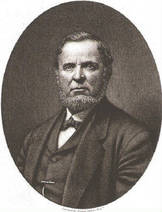
Jeremiah H. Bartholomew (1814-1884)
Third president of the NH&D and business associate of Anson Greene Phelps. Bartholomew was instrumental in getting the NH&D extended from Derby Jct. to Ansonia. Died on June 1, 1884. NH&D engines were draped in black on the day of his funeral [NHER/06/02/1884/04].
Third president of the NH&D and business associate of Anson Greene Phelps. Bartholomew was instrumental in getting the NH&D extended from Derby Jct. to Ansonia. Died on June 1, 1884. NH&D engines were draped in black on the day of his funeral [NHER/06/02/1884/04].
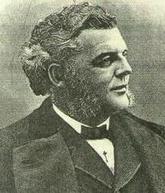
Hobart B. Bigelow (1834-1891)
Served as a mayor of New Haven from 1879 to 1881 during which time he pushed the pooling agreement between the NH&D and the NRR. Elected governor from 1881 to 1883.
Served as a mayor of New Haven from 1879 to 1881 during which time he pushed the pooling agreement between the NH&D and the NRR. Elected governor from 1881 to 1883.
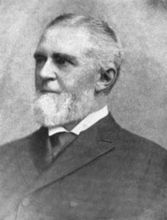
Jabez Abel Bostwick (1830-1892)
NY&NE president (1886-1892) and NH&D director, Bostwick was a millionaire and Standard Oil partner with John D. and William Rockefeller and Henry Morrison Flagler, the latter of whom also built the Florida East Coast RR and the Overseas Extension to Key West. Click here and here for more. [picadd120512]
NY&NE president (1886-1892) and NH&D director, Bostwick was a millionaire and Standard Oil partner with John D. and William Rockefeller and Henry Morrison Flagler, the latter of whom also built the Florida East Coast RR and the Overseas Extension to Key West. Click here and here for more. [picadd120512]
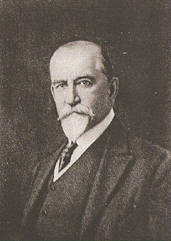
Charles F. Brooker (1847-1926)
Founder of the American Brass Co. NH&D's last vice president and also a director of the NYNY&HRR from 1893 to 1915.
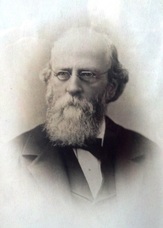
dwin Marble (1812-1903)
This photo appeared with the obituary article in the Register on the day of his death in 1903 [NHER/05/28/1903/01]. Active in New Haven civic and commercial affairs, Marble took over the presidency of Henry Hooker & Co., the carriage-making firm, in 1873 when Hooker died. He was one of the original NH&D directors, serving from 1867 to 1879, and the only director, who was not an officer, to have a locomotive named for him.
This photo appeared with the obituary article in the Register on the day of his death in 1903 [NHER/05/28/1903/01]. Active in New Haven civic and commercial affairs, Marble took over the presidency of Henry Hooker & Co., the carriage-making firm, in 1873 when Hooker died. He was one of the original NH&D directors, serving from 1867 to 1879, and the only director, who was not an officer, to have a locomotive named for him.
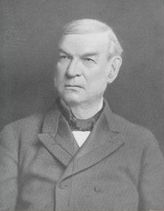
Nehemiah Day Sperry (1827-1911)
Appointed as New Haven postmaster by Pres. Lincoln in 1861 and served until 1886, and again from 1890 to 1894. Also served in the U.S. House of Representatives from 1895 to his death in 1911. Put Tyler City on the map by getting post office established there in 1874. An original and also longest-serving NH&D director from 1867 into the NYNH&H era in 1894.
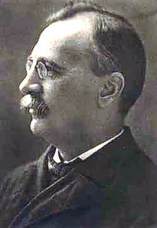
Morris Franklin Tyler (1848-1907)
Lawyer, NH&D director, and son of the second NH&D president. Acted as counsel for the Housatonic Valley RR in bidding for the NH&D. As head of the Southern New England Telephone Co. was perhaps involved in the use of the NH&D route by both SNET and ATT phone lines. Click here for more.
Lawyer, NH&D director, and son of the second NH&D president. Acted as counsel for the Housatonic Valley RR in bidding for the NH&D. As head of the Southern New England Telephone Co. was perhaps involved in the use of the NH&D route by both SNET and ATT phone lines. Click here for more.
